Achievement Trap: How America is Failing Millions of High-Achieving Students from Lower-Income Families
Advisory Board
Advisory Board
Andy Burness
Burness Communications
Patrick Callan
National Center for Public Policy and Higher Education
David Coleman
The Grow Network/McGraw-Hill
Paul Goren
Spencer Foundation
Kati Haycock
The Education Trust
Eugene Hickok
Dutko Worldwide (former Deputy Secretary,
US Department of Education)
John King
Uncommon Schools
Julia Lear
Center for Health and Health Care in Schools,
George Washington University
Delia Pompa
National Council of La Raza
James Shelton
Bill & Melinda Gates Foundation
Margaret Simms
Urban Institute
Tripp Somerville
Portland Schools Foundation
Clayton Spencer
Harvard University
Robert Templin
Northern Virginia Community College
Susan Traiman
Business Roundtable
Executive Summary


Today in America, there are millions of students who are overcoming challenging socioeconomic circumstances to excel academically. They defy the stereotype that poverty precludes high academic performance and that lower-income and low academic achievement are inextricably linked. They demonstrate that economically disadvantaged children can learn at the highest levels and provide hope to other lower-income students seeking to follow the same path.
Sadly, from the time they enter grade school through their postsecondary education, these students lose more educational ground and excel less frequently than their higher-income peers. Despite this tremendous loss in achievement, these remarkable young people are hidden from public view and absent from public policy debates. Instead of being recognized for their excellence and encouraged to strengthen their achievement, high-achieving lower-income students enter what we call the “achievement trap” — educators, policymakers, and the public assume they can fend for themselves when the facts show otherwise.
Very little is known about high-achieving students from lower-income families — defined in this report as students who score in the top 25 percent on nationally normed standardized tests and whose family incomes (adjusted for family size) are below the national median. We set out to change that fact and to focus public attention on this extraordinary group of students who can help reset our sights from standards of proficiency to standards of excellence.
This report chronicles the experiences of high-achieving lower-income students during elementary school, high school, college, and graduate school. In some respects, our findings are quite hopeful. There are millions of high-achieving lower-income students in urban, suburban, and rural communities all across America; they reflect the racial, ethnic, and gender composition of our nation’s schools; they drop out of high school at remarkably low rates; and more than 90 percent of them enter college.
But there is also cause for alarm. There are far fewer lower-income students achieving at the highest levels than there should be, they disproportionately fall out of the high-achieving group during elementary and high school, they rarely rise into the ranks of high achievers during those periods, and, perhaps most disturbingly, far too few ever graduate from college or go on to graduate school. Unless something is done, many more of America’s brightest lower-income students will meet this same educational fate, robbing them of opportunity and our nation of a valuable resource.
This report discusses new and original research on this extraordinary population of students. Our findings come from three federal databases that during the past 20 years have tracked students in elementary and high school, college, and graduate school. The following principal findings about high-achieving lower-income students are important for policymakers, educators, business leaders, the media, and civic leaders to understand and explore as schools, communities, states, and the nation consider ways to ensure that all children succeed:
Who They Are
- Overall, about 3.4 million K-12 children residing in households with incomes below the national median rank in the top quartile academically. This population is larger than the individual populations of 21 states.
- More than one million K-12 children who qualify for free or reduced-price lunch rank in the top quartile academically.
- When they enter elementary school, high-achieving, lower-income students mirror America both demographically executive summary 4 Executive Summary 5 and geographically. They exist proportionately to the overall first grade population among males and females and within urban, suburban, and rural communities, and are similar to the first grade population in terms of race and ethnicity (African-American, Hispanic, white, and Asian).
An Unequal Start
- Starting-line disparities hamstring educational mobility. Among first-grade students performing in the top academic quartile, only 28 percent are from lower-income families, while 72 percent are from higher-income families.
Losing Ground During K-12
- In elementary and high school, lower-income students neither maintain their status as high achievers nor rise into the ranks of high achievers as frequently as higher-income students.
> Only 56 percent of lower-income students maintain their status as high achievers in reading by fifth grade, versus 69 percent of higher-income students.
> While 25 percent of high-achieving lower-income students fall out of the top academic quartile in math in high school, only 16 percent of high-achieving upper income students do so.
> Among those not in the top academic quartile in first grade, children from families in the upper income half are more than twice as likely as those from lower income families to rise into the top academic quartile by fifth grade. The same is true between eighth and twelfth grades.
- High-achieving lower-income students drop out of high school or do not graduate on time at a rate twice that of their higher-income peers (8 percent vs. 4 percent) but still far below the national average (30 percent).
Unfulfilled Potential in College & Graduate School
- Losses of high-achieving lower-income students and the disparities between them and their higher-income academic peers persist through the college years. While more than nine out of ten high-achieving high school students in both income halves attend college (98 percent of those in the top half and 93 percent of those in the bottom half), high-achieving lower-income students are:
> Less likely to complete a bachelor’s degree than their higher-income peers (54 percent versus 78 percent)
> Less likely to attend the most selective colleges (19 percent versus 29 percent); > More likely to attend the least selective colleges (21 percent versus 14 percent); and
> Less likely to graduate when they attend the least selective colleges (56 percent versus 83 percent).
- High-achieving lower-income students are much less likely to receive a graduate degree than high-achieving students from the top income half. Specifically, among college graduates, 29 percent of high achievers from lower-income families receive graduate degrees as compared to 47 percent of high achievers from higher-income families.
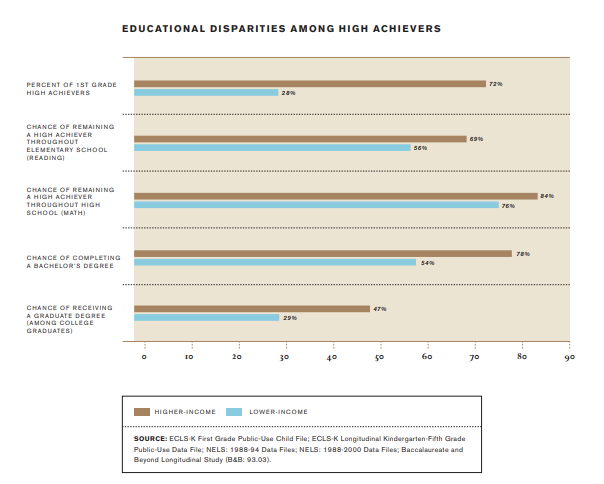
This pattern of declining educational attainment mirrors the experiences of underachieving students from lower-income families — they start grade school behind their peers, fall back during high school, and complete college and graduate school at lower rates than those from higher-income families. Our nation has understandably focused education policy on low-performing students from lower-income backgrounds. The laudable goals of improving basic skills and ensuring minimal proficiency in reading and math remain urgent, unmet, and deserving of unremitting focus. Indeed, our nation will not maintain its promise of equal opportunity at home or its economic position internationally unless we do a better job of educating students who currently fail to attain basic skills.
But this highly visible national struggle to reverse poor achievement among low-income students must be accompanied by a concerted effort to promote high achievement within the same population. The conclusion to be drawn from our research findings is not that high-achieving students from lower-income backgrounds are suffering more than other lower-income students, but that their talents are similarly under-nurtured. Even though lower-income students succeed at one grade level, we cannot assume that they are subsequently exempt from the struggles facing other lower-income students or that we do not need to pay attention to their continued educational success. Holding on to those faulty assumptions will prevent us from reversing the trend made plain by our findings: we are failing these high-achieving students throughout the educational process.
Next Steps
The time is at hand for targeting public policies, private resources, and academic research to help these young strivers achieve excellence and rise as high educationally as their individual talents can take them. Toward that end, our nation can take important steps to begin to bring this valuable and vulnerable population of students out of the national shadows:
> Educators, researchers, and policymakers need to more fully understand why, upon entering grade school, comparatively few lower-income students achieve at high levels and what can be done in early childhood to close this achievement gap.
> Federal, state, and local education officials should consider ways to broaden the current focus on proficiency standards to include policies and incentives that expand the number of lower-income students achieving at advanced levels.
> Educators must raise their expectations for lower-income students and implement effective strategies for maintaining and increasing advanced learning within this population.
> Educators and policymakers must dramatically increase the number of high-achieving lower-income students who complete college and graduate degrees by expanding their access to funding, information, and entry into the full range of colleges and universities our nation has to offer, including the most selective schools.
> Local school districts, states, and the federal government need to collect much better data on their high-performing lower-income students and the programs that contribute to their success, and use this information to identify and replicate practices that sustain and improve high levels of performance.
Importantly, as each of these and related efforts unfold, we must consider how advancing policies and practices that assist high-achieving lower-income students can be used to help all students.
The picture painted by this report runs counter to the expectations we have of our educational institutions. As we strive to close the achievement gaps between racial and economic groups, we will not succeed if our highest-performing students from lower-income families continue to slip through the cracks. Our failure to help them fulfill their demonstrated potential has significant implications for the social mobility of America’s lower-income families and the strength of our economy and society as a whole. The consequences are especially severe in a society in which the gap between rich and poor is growing and in an economy that increasingly rewards highly-skilled and highly-educated workers. By reversing the downward trajectory of their educational achievement, we will not only improve the lives of lower-income high-achievers, but also strengthen our nation by unleashing the potential of literally millions of young people who could be making great contributions to our communities and country.
Data Sources, Definitions, and Methodology
Data Sources
The analyses conducted for this report are based primarily on data from three nationally representative longitudinal surveys:
> Early Childhood Longitudinal Study — Kindergarten Cohort (ECLS-K) data were used to analyze the educational experiences of students in first and fifth grades. ECLS-K data are representative of first graders in 1999/2000 and of the kindergarten cohort in 2003/2004, when the majority of the original cohort was in the fifth grade.
> National Education Longitudinal Study (NELS) data were used to analyze the educational experiences of students in eighth and twelfth grades, and to analyze postsecondary entry and attainment rates. The NELS data relevant to this study are representative of eighth grade students in 1988; twelfth grade students in 1992; and the original twelfth grade cohort in 2000, eight years after high school graduation.
> Baccalaureate and Beyond Longitudinal Study (B&B) data were used to supplement the analyses of postsecondary experiences and graduate degree-attainment rates. The B&B data are representative of a cohort of students who completed baccalaureate degrees in 1992/1993.
Definitions Used in the Report
> High achievers are defined as students whose test scores place them in the top 25 percent of their peers nationwide on nationally normed exams administered as part of ECLSK and NELS. For the analysis of graduate school entry and attainment, high achievers were defined using a combined SAT/ACT measure provided in the B&B data (see Appendices A, C, and D for additional details.)
> Lower-income and higher-income (or upper-income) are defined as the bottom and top halves of the family income distribution, adjusted for family size.
> Persistence rate is defined as the percentage of a given group of high achievers at one grade (first grade in ECLS-K and eighth grade in NELS) who remain in the top academic quartile at a later grade (fifth grade in ECLS-K and twelfth grade in NELS).
> Improvement rate is defined as the percentage of a given group of students in the bottom three quartiles of achievement at one grade (first grade in ECLS-K and eighth grade in NELS) who move into the top academic quartile at a later grade (fifth grade in ECLS-K and twelfth grade in NELS).
Methodology
> Existence: The number of high-achieving lower-income students currently enrolled in America’s schools was estimated by applying the average percentage of lower-income high-achieving students observed at different grades in the ECLS-K and NELS data sets to total public and private enrollment for K-12 in 2004 (see Appendix B).
> Persistence and improvement rates: In an attempt to remove the effects of regression toward the mean, persistence rates were estimated by restricting the population of high achievers to those students who were in the top reading and math quartiles at the initial period. Separate math and reading persistence rates were then estimated by determining who remained in the top quartile of math performance or reading performance, respectively, at the later period. Improvement rates were estimated by restricting the population to those students whose test scores were not in the top quartile of either math or reading at the initial period. Separate math and reading improvement rates were then estimated by determining who had moved into the top quartile of math performance or reading performance, respectively, at the later period. (See Appendix C.)
> Postsecondary and graduate school entry and attainment: Postsecondary education entry rates were estimated using the follow-up data on NELS twelfth graders. Graduation rates represent the percentage of these students who completed a bachelor’s degree within the eight years following high school graduation. Graduate school entry and degree-attainment rates were estimated using the B&B data. (See Appendix D.)

Achievement Trap
Profile of 3.4 Million Exceptional Students
Millions of Overlooked Students
In the United States, more than 3.4 million K-12 students achieving in the top quartile academically come from families earning less than the median income.1 Although the challenges of low socioeconomic status may be difficult to overcome, the presence of these 3.4 million students provides hope to others caught in similar circumstances. Even though they possess fewer resources and often suffer from low expectations in the classroom, many lower-income students still find ways to excel, giving us reason to believe that students can perform at very high levels despite economic disadvantages.
High-achieving lower-income students constitute an important, but scarcely understood, segment of American society. At 3.4 million, they outnumber the individual populations of 21 states. They consist of students in poverty and those from working-class families. More than one million of them — or approximately one-third — are eligible for free or reduced-price lunch.2
They Reflect America
High-achieving lower-income students are found all across the country, within every race, among both gender groups, and in every sort of geographic area.3 Specifically, high-achieving lower-income first grade students:
> Live in urban, suburban, and rural areas in numbers proportionate to the overall first grade population in America.
> Exhibit a racial and ethnic composition similar to the overall first grade population in America.
> Consist of the same proportions of boys and girls as the overall first grade population in America.
While there is some evidence that white first graders are slightly overrepresented and African-American first graders are slightly underrepresented, those differences are quite small. In other words, high-achieving first graders from lower-income families are demographically and geographically very similar to the population of all US first grade students.4
The number of high-achieving lower-income students
nationally is larger than the individual populations of
21 states.

Disparity at the Starting Line
Although high-achieving lower-income schoolchildren can be counted in the millions, there should be many more. Specifically, we find that only 28 percent of top-quartile achievers in first grade come from families in America’s lower economic half, while 72 percent come from the top economic half. This finding suggests that disparities at the high end of achievement begin before children enter elementary school, a conclusion consistent with an emerging body of research on the effects that inferior early-childhood education has on school readiness of lower-income children.5
If childhood achievement levels were independent of economic background, we would expect that half of the top academic achievers would come from each half of the economic scale. The gap between our finding that 28 percent of high achievers in first grade are lower-income and the expectation that 50 percent should be lower-income suggests that nearly twice as many first graders from lower-income families could be achieving at high levels. Based on this expectation, 200,000 or more children from lower-income backgrounds appear to be lost each year from the ranks of high achievers before their formal education ever begins.6

Evidence suggests that lower-income children have inadequate access to the high-quality preschool programs that can significantly increase academic ability, cognitive development, social adjustment, and professional achievement.7 While that research has not been extended to analyze the effect of such programs specifically on advanced levels of achievement, it seems likely that the underrepresentation of lower-income children in high-quality preschool education programs contributes to the differences apparent in first-grade data. The demonstrated efficacy of many such programs in ameliorating overall achievement gaps suggests that the income gap at the high end of achievement can be likewise addressed, at least in part, by expanding access to high-quality early-childhood education for greater numbers of lower-income children.
Although they comprise
half the student population,
lower-income students
make up only 28 percent
of top achieving students
in first grade.
Disquieting Outcomes in Elementary and High School
It is reasonable to expect that our educational system would help to correct the high-achievement disparity that already exists between lower-income and higher-income students when they enter first grade. Specifically, public education is supposed to provide opportunities for all students to maximize their potential and to reduce achievement gaps as students progress through primary and secondary education. If the nation’s achievement gap is to narrow further, high achievers from lower-income families (like all students) must be given greater opportunity to grow academically over time.
For the group comprising the top quartile of academic achievers to become more representative of America’s income distribution, our schools need to achieve two main objectives:
> Ensure that high-achieving lower-income students continue to achieve (or more frequently “persist” as high achievers).
> Help more lower-income students move into the top quartile of academic achievement (or “improve” into the ranks of high achievers).
So how are we doing on these two fronts? Not well, based on this report’s analysis of national elementary and high school student performance data.8 As time progresses, high-achieving lower-income students do not hold their own academically as well as their more affluent peers. In addition, during elementary and high school, students from the lower economic half rise into the ranks of high achievers less frequently than students from the upper economic half.
Elementary School Achievement
From the very beginning of their formal education, high-achieving lower-income students fall behind their higher-income peers. Between first and fifth grades, 44 percent of high-achieving lower-income students fall out of the top achievement quartile in reading, whereas only 31 percent of high-achieving students from higher-income families do so. While our research reveals a small gap in math persistence rates, that difference is not statistically significant.9
Similarly, lower-income students who were not high achievers in first grade are decidedly less likely to rise into the high-achieving ranks in either reading or math by fifth grade. Examining the rates at which students move from the lower 75 percent of academic performance in first grade to the top 25 percent by the end of elementary school, we find that:
> 16 percent of lower-achieving students from the top economic half become high achievers in math compared to only 7 percent of those from the lower economic half.
> 17 percent of lower-achieving students from the top economic half become high achievers in reading compared, again, to only 7 percent of those from the lower economic half.
The gap widens further when we examine the highest and lowest income quartiles, adding more support to the conclusion that income is highly correlated with the likelihood of a student climbing into the top academic quartile.10
High-achieving lower-income students do not hold their own
academically as well as their more affluent peers. In addition,
during elementary and high school, students from the lower
economic half rise into the ranks of high achievers less
frequently than students from the upper economic half.
High School Achievement
In high school, the situation worsens for all lower-income students, whether or not they were already high achievers at the outset of high school. Indeed, our research provides strong evidence that lower-income high school students are less likely to remain or become high-achieving students than those from upper-income backgrounds.
For every 100 high-achieving eighth grade students in the lower economic half, 75 maintain their status as high achievers in math and 71 in reading at the end of high school, meaning that more than 25 percent fall from the top quarter of achievement. The retention rate among upper-income students is higher, with 84 percent remaining in the top level of achievement in math and 77 percent in reading. When we compare the lowest and highest income quartiles, the gap widens even further. For example, 28 percent of the poorest students slip out of the top achievement quartile in math compared to just 14 percent of the wealthiest students.
The difference in persistence between higher- and lower-income high achievers in high school is in large part driven by the gap among high-achieving boys. In math, only 13 percent of the higher-income boys fall out of the top quartile of achievement compared to 25 percent of lower-income boys. Similarly, in reading, 25 percent of higher-income boys fall out of the top quartile of achievement during high school compared to 36 percent of lower-income boys.
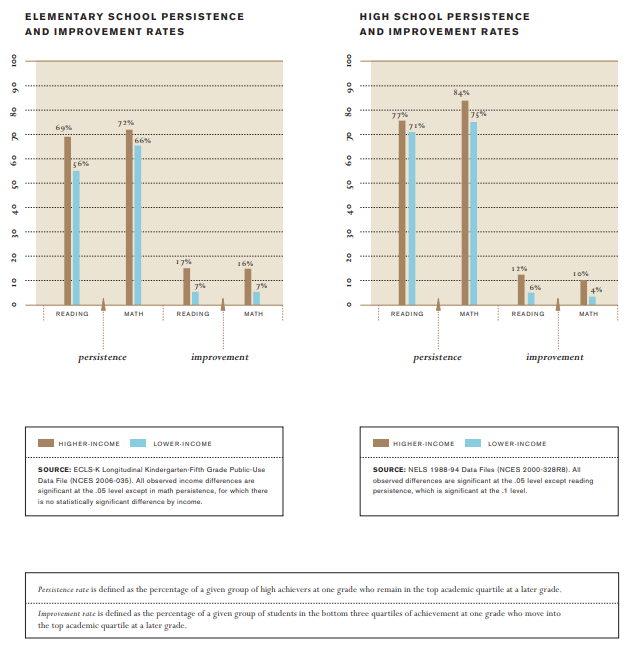
In terms of improvement, or the rate at which students move from the bottom 75 percent of achievement in eighth grade into the top achievement quartile in twelfth grade, students from the top economic half continue to outpace their lower-income peers by more than two-to-one. By the end of high school, ten percent of upper-income students improve into the top quartile in math compared to only four percent of lower-income students, while 12 percent of upper-income students rise to that level in reading, compared to only six percent of lower-income students. Again, the disparity deepens at income extremes: for example, 12 percent of students from the wealthiest income quartile improve in math compared to just three percent of those from the lowest income quartile.
There are also significant differences in the high school performance of different racial and ethnic groups within the lower-income high-achieving population. At the extremes, lower-income Asian students have a significantly better chance than other lower-income students of persisting in the top quartile of achievement in math during high school, while African-American students from lower-income families have a much smaller chance of rising into the top quartile in either math or reading during that period.
High School Completion Rates
While high-achieving lower-income students may drop down from the top academic quartile at a disproportionately high rate during high school, they are unlikely to drop out of high school altogether. Nationally, the dropout problem is severe, with nearly one out of every three students failing to graduate with their class.11 By contrast, 93 percent of students who were high-achieving and lower-income in eighth grade graduated on time, as did 97 percent of higher-income high achievers.12
While the rate at which high-achieving lower-income students fail to graduate on time is about twice that of their higher-income peers, rates for both groups are far below the approximately 30 percent observed for all students nationally. Indeed, these data suggest that taking steps to increase the number of lower-income students who enter high school as high achievers is one way to ameliorate America’s dropout crisis.
Fading Rather Than Persisting
As a whole, our elementary and high school findings reveal unrelenting inequities. Lower-income students lag significantly behind their higher-income peers both in the likelihood that they will remain high achievers over time and the odds that they will break into the high-achieving quartile. As discussed in greater detail in the final section of this report, much more needs to be done to determine the sources of these differences and to develop education strategies that can help ensure that high-achieving students in every classroom, regardless of their income and race, are engaged and challenged.
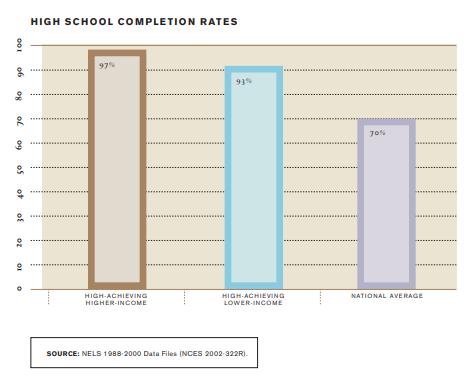
While high-achieving lower-income students may drop down
from the top academic quartile at a disproportionately high
rate during high school, they are unlikely to drop out of high
school altogether.
Alarming Gaps in College and Graduate School Completion
The educational disparity between lower- and higher-income high achievers continues after high school. In comparison to high achievers from the top economic half, high-achieving twelfth graders from the bottom economic half are less likely to attend highly selective colleges, more likely to attend less selective colleges, and, most importantly, much less likely to complete college and graduate school.
Strong but Lower College Entry Rates
Regardless of their income status, high-achieving students go to college at rates far above the national average.13 Among twelfth grade high achievers, 98 percent of higher-income students and 93 percent of lower-income students enter college. Though relatively small, this income-related gap in college entry rates is not without consequence. If lower-income high achievers entered college at the same rate as the higher-income group, an estimated 11,000 additional lower-income students would be exposed to higher education each year, at least some of whom would presumably go on to complete a bachelor’s degree.
Nonetheless, it is extraordinary that more than nine out of every ten lower-income high achievers pursue a college education. This rate is not only greater than that for all lower-income students, but greater than the rate for high-school graduates as a whole, of whom eight out of ten enter a postsecondary institution.14 Unfortunately, a troubling set of dynamics comes into play when we look at the graduation rates of the high-achieving lower-income student population.
The College Graduation Gap
While 78 percent of higher-income high-achieving twelfth graders can expect to complete a bachelor’s degree, the same is true for only 54 percent of lower-income high-achieving students.
Among these lower-income high-achieving students who begin college at a four-year institution, only 49 percent complete a bachelor’s degree within six years. For those who begin their postsecondary education in community college, the chances of transferring and completing a bachelor’s degree are even lower—a mere five percent of lower-income high-achieving twelfth graders successfully transfer from community college to a four-year institution and complete a bachelor’s degree.
The fact that almost half of the highest achieving low-income students in the country fail to graduate with a bachelor’s degree is deeply troubling given the personal benefits that accompany a college degree and the added contributions college graduates can make to the economy and society. As we look for ways to increase American competitiveness globally and to foster equal opportunity domestically, the loss of significant numbers of high-achieving students during their post-secondary years is inexcusable.
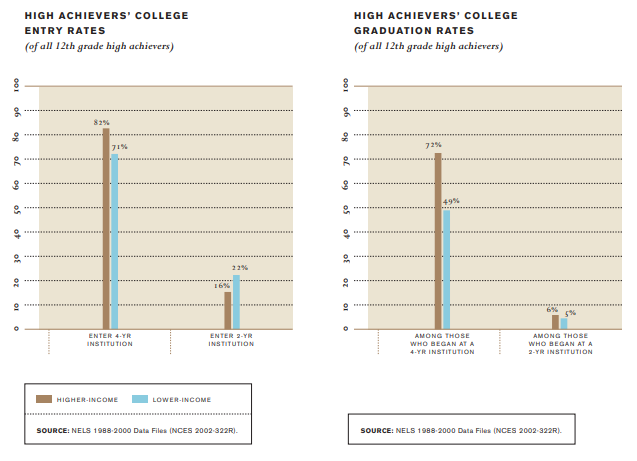
In comparison to high achievers from the top economic half,
high-achieving twelfth graders from the bottom economic
half are almost as likely to enter college but far less likely to
complete a bachelor’s degree.
Why so many high-achieving lower-income students do not complete college requires further study. It may be that financial limitations contribute to this shortfall, given the fact that college costs have risen at rates higher than both inflation and available need-based financial aid.15 Over the past five years alone, according to the College Board, the cost of going to college has increased 35 percent, while the main source of direct federal aid to lower-income students, the Pell Grant, has remained at just more than $4,000 annually per student.16 Moreover, recent reports suggest that increases in overall financial aid for college in the past decade have disproportionately benefited students from affluent rather than lower-income families.17 At the same time, many lower-income students lack sufficient information and guidance about financial aid and the college application process, keeping many qualified students from attending universities.18
The Link Between College Selectivity and College Graduation Rates
Although it is clear that we need to understand more fully the reasons that many high-achieving lower-income students do not complete college, our research reveals one factor that strongly predicts success for these students: the selectivity of the college they enter. Specifically, the more selective the college a high-achieving lower-income student attends, the more likely that student will graduate; the less selective the college, the more likely that the lower-income student will leave before graduating.
For the high-achieving lower-income group, graduation rates steadily drop from 90 percent to 56 percent as school selectivity decreases. In contrast, more than 80 percent of higher-income students received degrees regardless of where they went to college.19
Notwithstanding the greater benefit gained by lower-income high achievers when they attend highly selective colleges, it is the higher-income high achievers who do so more frequently. While enrollment rates in middle-selectivity schools are not statistically different for upper- and lower-income high achievers, at the extremes of selectivity, lower-income students fare worse. Specifically:
> 19 percent of high-achieving lower-income students attend the nation’s 146 most selective colleges, compared with 29 percent of high-achieving higher-income students.
> 21 percent of high-achieving lower-income students attend one of the 429 least selective colleges, compared with 14 percent of higher-income high achievers.
> 24 percent of high-achieving lower-income students attend community colleges while only 16 percent of high-achieving higher-income students do so.20
This lower rate of selective-college attendance likely has many causes.21 High-achieving lower-income students may not attend more selective schools because the cost of tuition, room and board, and travel are (or seem) prohibitive.22 Lower-income high school graduates may also pursue college experiences that are closer to home, appear less intimidating, or offer the flexibility they need to simultaneously hold a job. In addition, evidence suggests that lower-income students may receive guidance from their high school counselors that pushes them to attend less-selective institutions.23 Although the precise reasons are not fully understood, the fact remains that there are large numbers of students qualified for admission to a highly selective university who never even apply.24
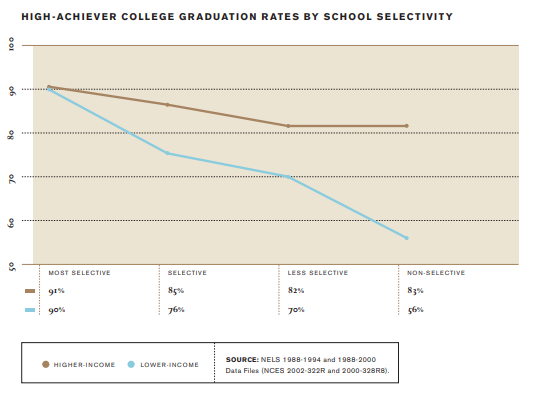
For the high-achieving lower-income group, graduation rates
steadily drop as school selectivity decreases. In contrast, more
than 80 percent of higher-income students receive degrees
regardless of where they go to college.
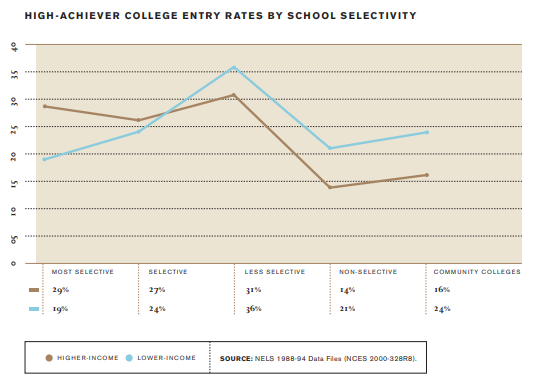
Motivated, talented students can, of course, receive a high-quality education at a community college or less-selective university. The unfortunate reality for high-achieving lower-income students, however, is that an important indicator of their future success in life — the likelihood of graduating from college — depends in substantial part on the selectivity of the school they attend.
Simply sending more high-achieving lower-income students to selective schools will not, in and of itself, close the graduation gap. Colleges at every level of selectivity should examine and emulate practices of institutions that graduate large numbers of lower-income students. A 2005 Education Trust report, for example, identifies a number of practices that promote high retention and graduation rates, such as focusing on the quality of undergraduate teaching, closely monitoring student progress, and ensuring that students are more fully engaged on campus during the freshman year.25 In addition, however, graduation rates for high-achieving lower-income students could be increased by making sure that they are ready for more selective colleges (rather than simply college-ready) and are aware of the rewards for attending such institutions.
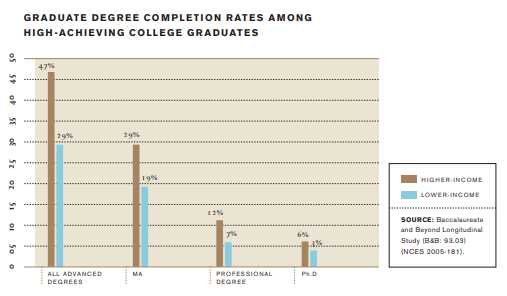
Graduate School Disparity
Among high achievers who graduate from both high school and college, the income-related achievement gap continues into graduate school. High achievers who manage to graduate from college are substantially less likely to earn master’s, professional, or doctoral degrees if they come from lower-income families. Furthermore, the disparity increases with the number of years required to complete the degree. When compared with a higherincome peer, a high-achieving lower-income college graduate is two-thirds as likely to obtain a master’s degree but only half as likely to earn a Ph.D. This disparity matters not only because the students themselves earn substantially more on average per year if they have a professional degree ($119,343) or a Ph.D ($93,593) than if they have a master’s degree ($68,302) or bachelor’s ($56,740), but also because our society is deprived of highly-educated scholars and professionals from diverse backgrounds.26
Findings Mirror Broader Challenges
The fading educational attainment of high-achieving students from lower-income families from first grade through postsecondary education should seem familiar: it is not unlike the experience faced by all low-income students. Low-income children generally suffer inadequate access to high-quality preschool programs and start school with lower levels of literacy and school readiness than children from more affluent families.27 During K-12, their achievement and attainment levels slip more and more as the years progress, culminating in high school experiences marked by low GPAs and high dropout rates.28 Finally, lower-income students who manage to graduate from high school and enter college experience a drastic shortfall in college graduation rates.29
Thus, the conclusion to be drawn from our research findings is not that high-achieving students from lower-income backgrounds are suffering more than other lower-income students, but that their talents are similarly under-nurtured. Even when lower-income students succeed at one grade level, we cannot assume that they are subsequently exempt from the struggles facing other lower-income students or that we do not need to pay attention to their continued educational success. Holding on to those faulty assumptions will prevent us from reversing the trend made plain by our findings: we are failing these high-achieving students throughout the educational process.
Next Steps
Our Shared Challenge
Students with academic talent but limited resources make up a generation of young Americans whose future is closely intertwined with the future of the nation. Quite simply, we need them, and they need a society that does not overlook their potential. They have demonstrated the capacity to make a significant contribution to our economic and social progress. A vaccine for malaria, technologies to address global warming, and the cure for cancer could emerge from the minds of lower-income students who currently are unlikely to obtain the education needed to make these contributions. Unless these students are provided strong educational opportunities, however, that potential will not be realized.
We must adopt a broader
vision that recognizes
the immense potential
of many lower-income
students to perform
at the highest levels of
achievement and
considers how to educate
them in ways that close
the existing highachievement
gap.
It is well-documented that the US economy’s evolution over the past 30 years has placed a premium on skills that require a postsecondary education. During the past decade, industry sectors in which jobs often do not require a college education — such as manufacturing and mining — have experienced negative growth, while the service sectors — the central hub of our “knowledge economy” — have grown nearly 20 percent. The US Department of Labor predicts that these trends will continue over the next decade, strongly suggesting the need for a more highly-educated workforce in the United States.30
While the incomes of people with a college education have always been greater than those of people who do not enter or finish college, this “college wage premium” has risen to historically high levels. In 2005, the earnings difference between those with a college degree and those with a high school diploma was greater than it has been at any point since 1915, when going to college was reserved for a relatively elite segment of the population.31 Today, average earnings for college graduates from all racial and gender groups are more than double the earnings for high school graduates and significantly higher than earnings for those who received only partial post-secondary education.32
In addition to earnings, a college education produces a range of benefits that are enjoyed not only by the graduates themselves but also by our nation as a whole. Reports by the College Board and the Institute for Higher Education Policy find that graduating from college correlates with better long-term health, a higher likelihood of voting, a smaller chance of being incarcerated, and less reliance on support from government-funded social support programs.33
Yet, even though our society has a stake in ensuring that high-achieving lower-income students complete their education and compete for higher-paying jobs, our nation largely ignores these students, and they remain absent from policy discussions. A review of current education policy initiatives, educational programs, and academic research suggests that a substantial shift is needed if more is to be done to help high-achieving lower-income students. Simply put, these students will not receive adequate help under the status quo, in which lower-income students are generally treated as educational underachievers who need to be brought up to average attainment levels. We must adopt a broader vision that recognizes the immense potential of many lower-income students to perform at the highest levels of achievement and considers how to educate them in ways that close the existing high-achievement gap.
What would it take for such a shift to occur? What initial steps would educators, policymakers, and academics need to take to help create better outcomes for these students?
Higher K-12 Standards
At the K-12 level, educators should view the findings in this report as a wake-up call, a signal that we are failing not only low-income students scoring below proficiency, but millions of students poised to achieve excellence. These findings raise a provocative question: Have we as a nation actually set our sights too low in our recent education reforms?
The major policy initiative driving K-12 practice today, the federal No Child Left Behind law (NCLB), does little in practice to encourage educators to learn about or close the high-achievement gap between higher-income and lower-income students. Because the core achievement goal established by NCLB requires schools to meet certain objectives regarding the number of students assessed to be proficient, the law does not set any standards related to students performing at advanced levels. As a result, NCLB creates no incentives for schools to maintain or increase the number of such students or to collect data on advanced learners.34
As schools and other educational programs for lower-income students have been pushed to increase the numbers of students who achieve proficiency, few have targeted services at high-achieving students or even assessed the effects of their programs on the number of lower-income students who reach advanced levels of learning. This reality is unlikely to change as long as proficiency remains the lone achievement mandate.35 If such policies allow schools to ignore the seven percent of the student population who are from lower-income backgrounds and achieving at advanced levels, we must ask whether the incentives under the law are the best they can be.
The time is ripe in the United States for a discussion about whether schools should be held accountable not only for meeting proficiency standards but also for the performance of students at advanced levels.
As policymakers, educators, civic leaders, and business leaders consider whether, and how, to strengthen and continue NCLB and related educational policy, they should pay close attention to research demonstrating that improving the academic environment for high-achieving students can benefit the entire student population.36 The time is ripe in the United States for a discussion about whether schools should be held accountable not only for meeting proficiency standards but also for the performance of students at advanced levels. At the very least, in light of the data presented in this report, policymakers and educators should begin a discussion at the federal, state, and local levels about whether and how to develop incentives that encourage schools to advance high achievement among lower-income students.
Better Information at the K-12 Level
Because federal education policy largely ignores advanced learners, inadequate information exists at both the state and federal levels about what is happening educationally to high-achieving lower-income students. To improve outcomes for lower-income high achievers, we will need better information about these students.
Inadequate information exists at both the state and
federal levels about what is happening educationally
to high-achieving lower-income students.
NCLB requires each state to establish a definition of “advanced achievement” and to collect and disseminate information on how well students achieve against state standards, including the number of lower-income students at advanced levels of achievement.37 In reality, however, when the federal government collects data on student achievement from states, it combines the number of students achieving at proficient and advanced levels into a single figure. As a result, the federal government does not provide states any incentive to measure and report on the advanced performance of high-achieving lower-income students. While looking for information at the state level, we found that, four years after the enactment of NCLB, nearly one-third of US states provide data that are inadequate to determine trends in achievement for advanced learners, or make no data on advanced learners accessible to the public.38
Stronger Engagement at the Local Level
In both public schools and out-of-school programs, there are few initiatives aimed at better serving lower-income advanced learners. There are, however, some notable exceptions among magnet public schools and certain charter schools, which have not only seen most of their students achieve proficiency, but have also helped many reach and remain at advanced levels.39 Several relatively small out-of-school providers target services to high-achieving lower-income students, and a few larger programs for the most talented students make efforts to include appreciable numbers of lower-income students.40 Nonetheless, at the school-district level and among the larger out-of-school children’s programs in low-income communities, little effort is made to serve high achievers or even to assess the number of advanced learners.
If the education of this valuable and vulnerable population of high achievers from lower-income homes in the United States is to improve, a more rigorous approach to innovation and evaluation in this field is needed. Policymakers, educators, and other civic leaders must ensure that public and private entities identify the best strategies for sustaining and improving lower-income students’ high levels of performance. Such an effort would require schools and out-of-school providers to collect and report data on their highest-performing students by income groups, and to test the effect that educational programs have on the number of high achievers and their yearly learning growth. Moreover, mechanisms must be established to allow local schools and other educational service providers to share what they have learned about what is working to better serve this noteworthy population.
Policymakers, educators, and other civic leaders must ensure that public and private entities identify the best strategies for sustaining and improving lower-income students’ high levels of performance.
Improved Accessibility and Success Rates in Higher Education
In higher education, lower-income students generally face several barriers to success, including decreasing levels of affordability, inadequate access to information about college, low levels of accessibility to a broad range of colleges, and insufficient programs to promote retention among those who enter college. Although existing research does not identify what role these barriers play in depressing the college-completion rate of high-achieving lower-income students, the fact remains that there are large numbers of students graduating from high school in the top academic quartile who never obtain bachelor’s or graduate degrees.
At the K-12 level, we need to expand awareness not merely that college is a possible destination point but also that a college degree is a critical step to a successful future. The fact that the number of guidance counselors in high schools has decreased, coupled with evidence that higher-achieving students from lower-income backgrounds are steered toward less-selective colleges, suggests the need to both expand and improve college-going guidance.41 Importantly, those entrusted with advising these students must understand and believe that lower-income students can succeed in a full range of post-secondary environments, including the most selective schools. Colleges and universities can play a role in providing better information to students by reaching out to high-achieving lower-income students in innovative ways. Promising efforts made in recent years include programs that send newly-trained college counselors to high schools with low levels of college-bound graduates,42 and others that offer financial aid instead of loans to students whose family incomes fall below various thresholds.43 Colleges and universities should build on these initiatives and pursue other promising ideas. For example, our research shows that nearly one in four high-achieving lower-income students attends a community college, but earlier studies have estimated that fewer than one out of every one thousand students at the nation’s most selective private universities transferred from community college.44 Surely the opportunity exists to help greater numbers of community college students attend competitive universities for which they are qualified.
Those entrusted with advising high school students must understand and believe that lower-income students can succeed in a full range of post-secondary environments, including the most selective schools.
College and university presidents, administrators, and faculty need to learn more about why high-achieving lower-income students drop out of college (especially less-selective colleges), and to emulate practices proven to increase graduation rates. Promising efforts aimed at improving degree-attainment rates among high-achieving lower-income students include providing the students with unique, intensive academic and social experiences, and establishing learning communities among groups of lower-income high achievers.45 However, while a significant amount of research has addressed how to improve higher-education degree-attainment rates for all students,46 inadequate attention has been paid to practices that help the attainment of high-achieving lower-income students.
Better Information at the Higher-Education Level
To target and assess efforts to increase college accessibility and degree attainment, better data will be needed. Insufficient information is available to assess the entry and success rates of high-achieving lower-income college students currently enrolled in post-secondary education. Most notably, the main federal sources of student data include information about race, gender, age, and other attributes of students at America’s colleges and universities, but they do not tell us much about the economic background of the students, including the number with Pell Grants. Indeed, the federal government does not require post-secondary institutions to report graduation rates by Pell Grant recipient status or any other income indicator. And while some states and institutions have worked to implement data systems that include information about the college success rates of lower-income students, these systems are not coordinated with one another.47 As a result, college leaders and policymakers cannot easily identify, implement, or fund programs that improve graduation rates among high-achieving lower-income students.
Better data must also be made publicly available if students are to have the information they need to assess the relative effectiveness of individual colleges. Currently, for example, a lower-income student deciding where to apply to college could not, for most public and private institutions, find an answer to the simple question: “What is the graduation rate among students like me?” The federal government should provide guidance to institutions and to states that are working to develop the kinds of data systems needed to collect this information, and should provide incentives for them to collect and use the data to identify and implement initiatives that improve the graduation rates of lower-income students. Such data should also be made centrally accessible so that policymakers, administrators, government officials, and, importantly, lower-income students and their families can assess the effectiveness of accessibility and retention initiatives within individual colleges and state systems.48
Greater Attention within Academic Research
As noted throughout this report, academic research has focused little on high-achieving lower-income students. Most reports on achievement differences between income groups divide the population by income and then look at average achievement for each group.49 Consequently, we have a clear picture that students from lower-income families tend to perform worse on average than their more affluent peers, but little information about what is happening at the high end of achievement.
Studies have found that lower-income students start kindergarten with substantially lower cognitive skills than their more advantaged peers,50 attend worse schools,51 score lower on standardized tests,52 enroll less often in AP classes,53 are less likely to graduate from high school, and less frequently go to college.54 The limited research available on high-achieving lower-income students suggests that similar deficits exist for this population. For example, summer learning loss tends to be greater for high-achieving students from low-income schools than for high-achieving students from high-income schools.55 Gifted students from the bottom socioeconomic quartile are more likely to drop out of high school than those from the top quartile.56 Additionally, large numbers of low-income students qualified to attend the most competitive universities never even apply.57
Nonetheless, the limited available research leaves significant gaps in our understanding of the obstacles facing lower-income high-achieving students. We hope that the data in this report will spur additional research efforts addressing such questions such as:
> What effect does early childhood education have on lower-income students’ emergence as high achievers in first grade and beyond?
> What effect do different efforts to increase the number of low-income K-12 students achieving proficiency have on the number who remain or become high achievers?
> How does serving high-achieving lower-income students in a targeted way affect the educational outcomes of other students?
> What are the most effective counseling, teaching, and financial aid strategies for increasing the rates at which high-achieving lower-income students attain college and graduate degrees?
> What can be done to overcome the barriers that prevent additional lower-income students from applying to more selective colleges and, when they are accepted, attending those institutions?
> Why do high-achieving lower-income students have significantly lower graduation rates when they attend less-selective colleges and universities?
Conclusion
When viewed as a single narrative, the experience of the high-achieving lower-income student is alarming. It is marked by disadvantage through elementary school, unequal opportunity in high school, and inferior rates of college and graduate-school completion. The simple summary of the quandary facing the 3.4 million high-achieving lower-income students is that, at every step of the educational process, they face significant obstacles to continuing their high levels of achievement. They have the ability to excel in college and achieve the highest levels of success in their chosen fields, but they are less likely to have the social and financial resources necessary to get there.
That these facts are so little known has helped to perpetuate a general public attitude that these students either do not exist in appreciable numbers or are continuing to succeed in their current environments. As this report shows, the opposite is true. There are 3.4 million lower-income high achievers who need support to sustain and improve upon their high levels of academic achievement during K-12. Once they graduate, they need help to ensure that they complete the undergraduate and graduate programs necessary for them to reach their full potential.
At their best, American schools are engines of social mobility, enabling individuals from the toughest economic circumstances to advance as far as their abilities and hard work can take them. But these engines of mobility are sputtering for those lower-income students who are showing the most academic promise. Our nation can, and must, do better. We must ensure that our educational systems and reforms advance the life prospects of all students, including those disadvantaged students already excelling, who have great potential to make significant contributions to our society and world.
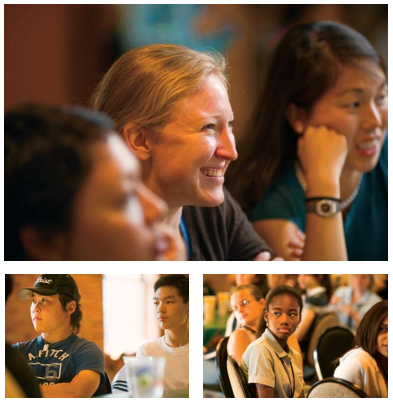

Student Profiles
Kourtney Lewis

Subject to low expectations and unchallenging coursework, many lower-income students with the ability to excel languish in their schools for years, performing well below their potential. Too often, these students never rise to achieve at top levels. Kourtney Lewis’ story illustrates what can happen when such students are challenged to perform at the highest level.
Although she always believed she was academically talented, Kourtney’s performance did not place her anywhere near the top of her class. She spent first, second, and third grades at a public school in her neighborhood, where she felt that her teachers were ill-equipped to feed her curiosities. “When I was in elementary school, my teachers didn’t push me,” she says. “They knew that I was different from other students and that school wasn’t a challenge for me, but they couldn’t do anything for me.”
At the age of 10, Kourtney transferred to a new school district as part of Metropolitan Council for Educational Opportunity (METCO), a voluntary desegregation program. The move ultimately afforded Kourtney opportunities she never had at her local school. Her new school district had a smaller student-to-teacher ratio and provided more resources per student than Kourtney’s neighborhood school.
When she arrived at her new school, Kourtney was placed in a remedial program. For a student who craved greater intellectual challenge and stimulation, being in remedial education was difficult. “When I was in the remedial class, I wanted to be independent and I wanted to learn more, which made it really hard for me.”
It took the help of her mother, a mentor, and an intensive summer program to move Kourtney from the remedial program into advanced courses, where she has since excelled. With high expectations from those around her, Kourtney now says, “I know what I have to do to get an A.” And Kourtney has found earning top marks not just possible but probable. In 2006, she was recognized by METCO for earning the highest grade point average of all students in her grade in the Boston-area program.
Now in her sophomore year at a public high school in Lincoln, Massachusetts, Kourtney has her sights set on attending Stanford University or an historically black college or university when she graduates. She wants to pursue a career in law.
Tanner Mathison

Throughout America, there are millions of students excelling in school despite their families’ lower income levels. While they may encounter supportive teachers or challenging programs, these students’ opportunities are often prescribed by the limited educational resources available in their local communities. Tanner Mathison exemplifies such students.
Tanner vividly remembers when he first realized he might be “one of the smart kids.” It happened in fifth grade, when he won a toothpick bridge-building contest at his elementary school in rural Oregon. Once his bridge held 1,500 pounds without yielding, they stopped testing it.
Even at this early age, Tanner was feeling out of place in rural Oregon. His father had passed away a few years earlier, and the modest life his mother could afford did not include sufficient outlets for his academic interests. It seemed to Tanner that his teachers were often either not equipped or not motivated to encourage advanced students like him. “At my school in Oregon, no one talked about preparation for the most selective colleges—or college at all, outside of the typical options.”
Despite these challenges, Tanner persisted. Although he found subjects that interested him and challenged him to excel, he wanted more. While in middle school, Tanner earned a scholarship to attend private school. At his new school, Tanner encountered dedicated teachers and rigorous programs that unlocked his potential and captured his varied interests. In the summer, he also enrolled in courses that challenged him— engineering courses at Johns Hopkins University and a Duke University program in London focused on world politics. Tanner is now a freshman at Dartmouth College.
Tanner recognizes how fortunate he has been. He knows that most of the nation’s children do not have opportunities to attend schools — public or private — that adequately nurture and challenge student abilities. “There are a ton of smart, low-income students in this country who don’t have someone to speak for them—no one to get them access to the programs and enrichment they need,” Tanner says. “In modern society we tend to associate monetary gains with success, and sadly, with this paradigm, we often fail to recognize that academic talent can rest within lower-income students.”
Sarah Brown-Hiegel

Each year, thousands of students from lower-income backgrounds leave college, falling short of the goals they set for themselves when they completed high school at the top of their graduating classes. Once in college, these high achievers face not only financial challenges, but the realization that their high school coursework did not prepare them for the rigors of higher education. Sara Brown-Hiegel is one such student.
Sara grew up in South Central Los Angeles, where she attended public school. Through hard work and the encouragement of her parents, Sara was accepted to a University of Southern California (USC) program for students with promising academic records. Sara felt lucky to be part of the program, as she knew her parents would not be able to afford to send her to college—especially to a school with tuition as high as USC’s.
Through USC’s Pre-College Academy, Sara participated in afterschool programs, test preparation courses, and Saturday tutoring sessions. By doing well in the program and earning strong grades through high school, Sara secured admission to USC and a guaranteed full scholarship for nine semesters.
As hard as she worked in high school, Sara found college much more difficult than she expected. Initially, she was able to manage the requirements of college, but soon academic demands began to wear on her. “College was like a slap in the face,” she says. “I realized that all that preparation was to get me into college, not for college.”
“For the first year and a half I gave it my all… but then after a while I lost my motivation,” she says. Sara wishes those at her high school had better prepared her for the workload and personal responsibility required during college. She felt that all the hand-holding she received through high school left her with a disadvantage once she had to do it on her own.
Sara now grapples with her future at USC after a full year out of school following three semesters on academic probation. She aspires to be a published writer and acknowledges that a college degree would be an important step in that direction. “It’s worth it,” she says. “Higher education is important.” And yet, as Sara prepares to reenter USC, she cannot predict if and when she will complete her degree.
Ryan Catala

Numerous challenges face the million-plus high achievers nationally who are living in or near poverty. Living in families that endure significant financial hardship, these students often become sidetracked. For many of these students, community college offers a second chance to prove themselves academically. Ryan Catala offers one example.
Ryan grew up too quickly. Although family struggles forced him to live with foster families and change schools frequently, Ryan was placed in a gifted program at an early age. But like many young people who find themselves in turbulent environments, gangs and drugs eventually lured him away from academics.
By the time he was 17, Ryan was in prison. While sitting in his jail cell, Ryan realized that education was the way out and that he had much more to offer the world. After serving his time, he lived at the YMCA in his hometown and found a job there. He surrounded himself with supportive mentors who helped redirect him toward education and a productive life. He earned his GED and enrolled in Westchester Community College, commuting two hours to campus from the YMCA each day.
“The bus I took to school would pass the jail where I had been incarcerated,” Ryan recalls. “It was a daily reminder of how bad my life had been, and it became symbolic. I was getting an education, and even though my school was less than a mile away from the jail, it couldn’t be more different in the direction it was taking me.”
In community college, Ryan encountered teachers who supported and encouraged him to pursue his dreams. He completed his associate’s degree and transferred to Columbia University. Spurred by his experience, Ryan is interested in politics and the judicial system, and is currently working for the Yonkers City Council President. His long-term plans include law school, which he hopes will provide him with opportunities to help troubled youth.
Ryan recognizes that the difficulties he faced in childhood are not uncommon, particularly for low-income children. “I don’t think people understand what it means to go without a meal, or even several meals, because you don’t have the money,” he says. “Imagine dealing with that at the same time as finals and term papers. That is often the reality for low-income students.”
Scott Keller

Even when they receive a quality education early on, many high achievers from working-class families find their educational opportunities narrowing as they get to high school and consider college. Notwithstanding their hard work and continued excellence, their educational progress is often stunted by the financial realities faced by their families and communities. Scott Keller’s story is illustrative.
Scott grew up on a livestock farm outside Humboldt, Illinois. According to the 2000 census, Humboldt is a town of 481 with a median household income of $45,625. Farms dot the landscape, and the largest employers are broomcorn factories.
Going to school in a town with approximately 150 children, Scott graduated with just 52 other students. While his small school offered personal attention, he felt stifled by the limited number of advanced classes. “Being from a smaller, poorer school district made for some disadvantages compared to what was offered to other students.”
Still, Scott stood out as the class valedictorian. While he knew what it would take to be first in his class at his local high school, he also recognized that fulfilling his dream of pursuing a career in medicine would require succeeding on a bigger stage. Like many students at the top of their class, Scott wanted to attend a top four-year university. But his high school had not fully prepared him, and finances were tight. Instead, he attended Lake Land Community College in Mattoon, Illinois, with a full scholarship. Scott is grateful for his community college education, recognizing that it offered him the opportunity to continue working towards his goal of becoming a doctor. “Education is the path upward and it opens doors—there’s no way around it,” he says. “If you have an education, there are so many more opportunities available than if you don’t.”
Unlike many other lower-income high-achievers, Scott’s education will continue beyond community college. A scholarship to a four-year university has unlocked a new set of opportunities for this aspiring doctor. Scott is on track to fulfill his dreams and to contribute to the health and welfare of his community.
Appendices
Appendix A: Data sources and definitions
Data Sources
The analyses conducted for this report are based, primarily, on data from three nationally representative longitudinal surveys:
> The Early Childhood Longitudinal Study — Kindergarten Cohort (ECLS-K)
> The National Education Longitudinal Study (NELS)
> The Baccalaureate and Beyond Longitudinal Study (B&B)
Data from ECLS-K were used to study the educational experiences of students in first, third, and fifth grades, while NELS data were used to analyze students in eighth and twelfth grades. Some members of the NELS cohort were also surveyed eight years after the majority graduated from high school; data on these students span sufficient time after graduation to examine the postsecondary experiences of the cohort.
It is important to note that the NELS and ECLS-K were conducted at different points in time. The NELS data are representative of: eighth grade students in 1988; tenth grade students in 1990; twelfth grade students in 1992; and twelfth graders from the 1992 class in 2000. The ECLS-K data are more recent and represent: kindergartners in 1998/99; first grade students in 1999/2000; the kindergarten cohort in 2001/02, who are mainly third grade students; and the kindergarten cohort in 2003/04, who are mainly fifth grade students.
B&B followed a cohort of students who completed their baccalaureate degrees in 1992/93. These data support a different analysis of postsecondary experiences than can be conducted using the NELS data. In particular, B&B data were used to examine the graduate school experience because the study cohort is representative of students most likely to attend graduate school. Further, the 10 years between the first and most recent survey waves mitigates the confounding influence of delayed graduate school entry, thereby producing a better portrait of graduate attendance and attainment. More details on these analyses are in Appendix D.
Defining High Achievement and Lower-Income
For the research on elementary and high school experiences, high achievement is defined as the top quartile of academic performance on nationally normalized exams administered as part of the ECLS-K and the NELS. Lower-income is defined as the bottom half of the family-size adjusted income distribution.
Academic Performance
For both the ECLS-K and the NELS, item response theory (IRT) had been employed to compute test scores that are comparable between students. IRT scoring uses the overall pattern of right and wrong responses to estimate a student’s true ability, taking into account the difficulty, discriminating ability, and “guess-ability” of the items administered.58 To further facilitate comparisons between students, norm-referenced measures of achievement, i.e., estimates of achievement level relative to one’s peers, were used in this research. A high norm-referenced (standardized) score for a particular subgroup indicates that the group’s performance is high in comparison to other groups. It does not mean that group members have mastered a particular set of skills, only that their mastery level is greater than a comparison group.
While separate norm-referenced reading and mathematics test scores are available for grades one, three, and five, where possible, we preferred to define the top academic quartile using a composite measure of reading and math performance at each grade level. Thus, for the ECLS-K, composite test scores were constructed following the procedure used to create the composite test scores available on the NELS data file for grades eight and twelve. The first step was to create an equally weighted average of the standardized reading and mathematics scores.59 For cross-sectional analyses, the resulting values were then re-standardized within year, using the appropriate cross-sectional survey weight, to have a mean of 50 and a standard deviation of 10. For longitudinal analyses, the reading, math, and composite test scores were re-standardized within year, using the appropriate longitudinal survey weight, to have a mean of 50 and a standard deviation of 10 across the same cohort of students at each grade.
The ECLS-K variables used to determine academic performance differed slightly between the cross-sectional and longitudinal analyses. Updated IRT scores were released on later data files but only for the students who remained in the longitudinal survey. Therefore, updated measures were not available for all students in the first and third grade cross-sectional samples. For cross-sectional analyses, composite test scores for first grade students were created using the variables, C4RRTSCO (reading IRT t-score) and C4RMTSCO (math IRT t-score). The corresponding variables, C5R2RTSC and C5R2MTSC, were used to create composite test scores for third grade students, and the variables, C6R3RTSC and C6R3MTSC, were used to create fifth grade composite test scores. For longitudinal analyses, the updated equivalents of the first grade reading and math IRT scores, C4R3RTSC and C4R3MTSC, were used along with C6R3RTSC and C6R3MTSC. See Appendix C.
Composite test scores already existed in the NELS data file and updated IRT scores were available for all students. The variables used to determine academic performance in the cross-sectional analyses were the reading and math composite IRT t-scores, BY2XCOMP and F22XCOMP, for eighth and twelfth grade, respectively. For longitudinal analyses of high school experiences, the following reading and math IRT tscores were used: BY2XRSTD, BY2XMSTD, F22XRSTD, and F22XMSTD. See Appendix C.
Academic Quartiles
Academic quartiles were defined in slightly different ways for the cross-sectional and longitudinal analyses conducted as part of this research. The cross-sectional quartiles were determined by the test performance of the “in grade” students in the sample, using appropriate cross-sectional weights. Using this definition, high achievement is to be interpreted relative to the performance of the nation’s students in a given grade.60
For the longitudinal analyses, we used a cohort-based definition of academic quartiles. The longitudinal quartiles were determined by the test performance of the same cohort of students at each point in time, regardless of whether they subsequently remained “in grade”. Quartile boundaries were computed using appropriate longitudinal weights. While this definition differs slightly from that used for the cross-sectional analyses, it does facilitate “zero-sum” accounting of the flows into and out of specific academic quartiles over time. Using this definition, high achievement is to be interpreted relative to the national population represented by the initial cohort, keeping in mind that not all these students remain “in grade” as they progress through school.61
Adjusted Income
Family income was adjusted for family size to develop a normalized measure of financial need. Following Johnson, Smeeding, and Torrey (Monthly Labor Review, 2005),62 we used a constant-elasticity, single-parameter equivalence scale which is created by dividing income by the square root of family size. In other words, income was adjusted in a non-linear fashion to account for the diminishing financial burden of increased family size. While other scales exist (e.g., Henderson, BLS poverty scale, and the new OECD equivalent scale),63 we chose to use this scale because it offers a reasonable adjustment with minimal informational requirements.
In both the ECLS-K and NELS data files, family income is available only as a categorical variable representing income ranges. Family-size adjusted income was computed by dividing the midpoint of the income range by the square root of family size. Due to lumping of the resulting family-size adjusted income values, a further procedure was used to assign students to income quartiles. This involved modeling the log of family-size adjusted income and, where necessary, using predicted values from the model to distinguish between cases with the same actual value.
The following variables from the ECLS-K data files were used as the measures of family income in the first, third, and fifth grades, respectively: W1INCCAT, W3INCCAT, and W5INCCAT. No direct measure of family size was available so this was estimated from information on family composition. The NELS variables used as the measures of family income in the eighth and twelfth grades were, BYFAMINC and F2P74, respectively. The variables, BYFAM-SIZ and F2FAMSIZ, indicated family size.
Use of Average Income for Longitudinal Analyses
Income is known to fluctuate between any two periods of time (see, for example, Rose and Hartmann, 2004).64 Therefore, even though the amount of fluctuation between above and below the median level over time is small, we chose to remove this component of change from the longitudinal analyses of academic performance by using average family-size adjusted income over the period of interest.
Income Quartiles
The definition of lower-income used in this study depends only on halves of the family-size adjusted income distribution. Operationally, however, lower-income was determined by forming and then combining income quartiles. Income quartiles were also defined in slightly different ways for the cross-sectional and longitudinal analyses. However, unlike the cross-sectional academic quartiles, the corresponding income quartiles were determined using data on all students in the cross-sectional sample, using appropriate weights. Using this definition, lower-income is to be interpreted relative to the nation’s students who: started kindergarten in 1998/99 or first grade in 1999/2000 (for ECLS-K); started eighth grade in 1987/88 (for NELS eighth grade estimates); and who started eighth grade in 1987/88 or tenth grade in 1989/90 or twelfth grade in 1991/92 (for NELS twelfth grade estimates).
For the longitudinal analyses, income quartiles were defined using average income over the period of interest and were created using a procedure identical to that for forming the longitudinal academic quartiles. Using this definition, lower-income is to be interpreted relative to the national population represented by the initial cohort, keeping in mind that not all these students remain “in grade” as they progress through school.
Missing Data and Survey Estimates
Missing Data
For the ECLS-K and the NELS, missing data values for key analytic variables (test scores, family income, and family size) were imputed. The imputation approach varied depending upon the variable and the survey. For example, missing data on family size were completed logically based on other relevant information. Family income had already been imputed in the ECLS-K data files, but for the NELS it was imputed using hot-deck procedures. Missing first, third, and fifth grade test scores were also imputed using hot-deck procedures. For grades eight and twelve, test scores were imputed using the multiple imputation procedure available as part of the SAS software package. However, multiple values (five) were only created for twelfth-grade scores in order to reflect the higher level of missing data for this grade and to incorporate this uncertainty into associated estimates of variance.
Analytic Weights and Eligibility
Cross-sectional analyses of first, third, and fifth grade students were weighted using the variables C4PWO, C5PWO, and C6PWO, respectively. The replicate weights associated with each of these full sample weights were used for variance estimation. “In grade” students were identified using the variables T4GLVL, T5GLVL, and T6GLVL. Longitudinal analyses based on the ECLS-K data were weighted using the variable C456PWO (along with the associated replicate weights). These weights are appropriate for analyses that involve both parent- and child-level data, for example, family income and student academic performance.
Cross-sectional analyses of eighth and twelfth grade students were weighted using the variables BYQWT and F2QWT, respectively. “In grade” students were identified using the variables BYQFLG and F2SEQFLG. Longitudinal analyses of transitions between eighth and twelfth grades (including studies of dropout status) were weighted using the variable F2PNLWT.
Statistical Testing
Each of the three surveys used in this research — ECLS-K, NELS, and B&B — employed complex survey designs that must be accounted for when computing standard errors, confidence intervals, and conducting statistical tests. Release 9.0.1 of the SUDAAN software package was used for this purpose. For ECLS-K, variances were estimated using the replicate weights provided on the data files. For the other two surveys, strata and primary sampling unit (PSU) information was used in variance estimation. For NELS, strata and PSU identifiers are nested in the student ID, while the relevant variables from the B&B data file are TAYSTR03 and TAYREP03. The multiple imputed values for missing twelfth grade test scores were properly taken into account by the variance estimation procedures.
Appendix B: Demographics
Number of High-Achieving Lower-Income Students in K-12
Cross-sectional estimates of the percentage of students who are high-achieving lower-income students are given in Table 1 and
average approximately 6.5% of each grade.

Recall that ECLS-K and NELS data were collected during different time periods. Therefore, to make estimates time-comparable, we adjusted each of the above class sizes to a common year by using enrollment data (not shown) from the Projections of Education Statistics through 2015 and from tables provided by NCES.65 It is necessary to assume that the relationship between income and academic performance does not change over time for this adjustment to be meaningful. Using this process we were able to estimate that 3.4 million high-achieving lower-income students existed in the K-12 education system as of 2004. This estimate was calculated using the average percentage of such students per grade (6.5 percent based on the figures in Table 1), assuming that this average applies equally well to the grades for which we had no estimates.66 This assumption is reasonable given the consistency of the estimates across grades and data sources.
Number of High Achievers Eligible for Free or Reduced-Price Lunch
The following analysis was used to estimate the number of high-achieving lower-income students who qualify for the federal subsidized meals program. Since the family-size67 adjusted income measure used in this report to define lower-income differs from the measure used to define poverty, it was necessary to compare tables of survey income ranges by family size with historic poverty guidelines for the appropriate years.68 Upper income limits corresponding to 1.3 and 1.85 times the poverty line were derived for each family size according to the guidelines, and the percentages of high-achieving lower-income students with family incomes below these limits were estimated. To obtain conservative estimates, only income ranges that fall entirely below the upper limits were considered eligible. For example, in 1988 the poverty line was $5,770 for one person plus $1,960 for each additional family member. For a family of four, this equates to free and reduced-price lunch eligibility limits of $15,145 and $21,553, respectively. The closest NELS income ranges are $15,000- $19,999 and $20,000-$25,000, but since $21,553 does not fall entirely within the second interval, only eighth graders whose family incomes were below $19,999 were counted as eligible for free or reduced-price lunch.
Using this methodology, the percentages of high-achieving lower-income students estimated to be eligible for free or reduced-price lunch at the time of the relevant survey waves are: 70 percent for first grade, 58 percent for fifth grade, 49 percent for eighth grade, and 54 percent for twelfth grade. The decrease in eligibility between first and fifth grades may result from one or more of the following facts: ECLS-K was not freshened to be fully representative of fifth graders, the above estimates are based on “in grade” students, and out-of-grade status appears to be correlated with income. Based on the assumption that families of high-achieving lower-income students are similarly spread across the income ranges in the grades for which we have no estimates, we conclude that at least one million (and likely more) of the estimated 3.4 million high-achieving lower-income students in 2004 were eligible for free or reduced-price lunch.
First Grade Representation by Gender, Urbanicity, and Race
Cross-sectional estimates of the distributions of gender, type of geographic area, and race/ethnicity among high-achieving lower-income first grade students were computed and compared to these distributions for all “in grade” first graders.69 The results are given in Tables 2–4. The following variables from the ECLS-K first grade data file were used for this purpose: RACE, GENDER, and R4URBAN.
The variable RACE was condensed; in particular the values 3 and 4 were recoded as Hispanic and the values 6, 7, and 8 were combined as American Indian, mixed race, and other. Estimates for the latter category are not reported because, even when aggregated, sample sizes are small. The variable, R4URBAN, was recoded such that “large and mid-sized city” is labeled “urban”, “large and mid-sized suburb and large town” is labeled “suburban”, and “small town and rural” is labeled “rural.”
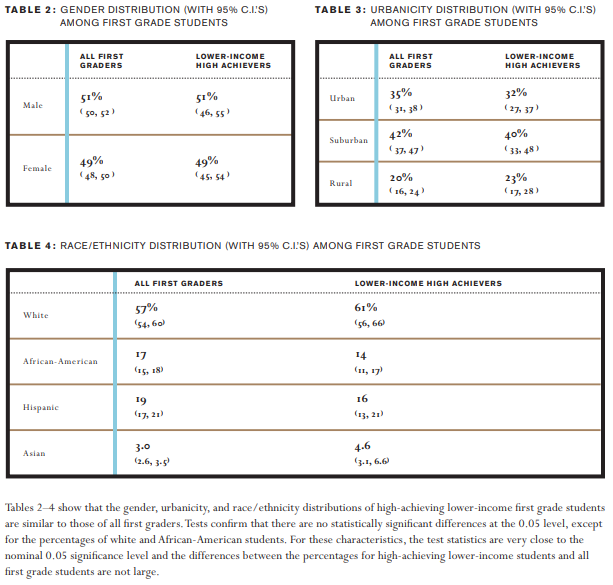
Appendix C: Persistence and Improvement Rates
Methodology and Results
This report examines the persistence rates of high achievers, defined as the percentage of students in the top test quartile at a given grade who are still high achievers at a later grade. It also examines the improvement rates of students who are not high achievers, defined as the percentage of students in the bottom three test quartiles at a given grade who have moved into the top quartile at a later grade. These rates are computed using first and fifth grade data from the ECLS-K, and using eighth and twelfth grade data from the NELS. Note that in neither case do the estimates take into account movement of students into and out of the top test quartile in grades between the two endpoints.
Analyses of change using test scores must consider a statistical phenomenon known as regression toward the mean. In this setting, regression toward the mean results from the fact that there is some measurement error associated with the observed test scores. Consequently, scores that were above or below the mean on an initial test will tend to move toward the average on a subsequent test. If, say, a particular group of students has a higher-than-average mean score, the group mean will regress toward the overall mean. The more extreme the group of interest, the greater the degree of regression toward the mean is likely to be, and herein lies the main difficulty in interpreting changes in performance for high-achieving students. When a study focuses on a group with a mean score that differs from the overall mean, such as students in the top (or bottom three) test quartile(s), it may be difficult to distinguish real changes in performance over time from artificial changes due to measurement error. The practical importance of these observations is that income-based differences in observed persistence and improvement rates may be, at least in part, the result of test measurement error, and therefore not indicative of real differences in change in academic performance over time. In other words, differences in observed persistence and improvement rates may be due to measurement error and point-in-time differences in the test score distributions of lower- and higher-income students.
While most of the analyses in this report are based on test scores that are a composite of reading and math scores, we exploited these individual subject components in an attempt to remove the effects of regression toward the mean on estimates of persistence and improvement rates. The method we used relies on the validity of the assumption that true underlying ability in math and reading is correlated while measurement error in the respective test scores is not.70 While this is not a perfect method (since, for example, students in the data sets were assessed in both subjects on the same day), it is better than attempting to draw inferences about change in academic performance from the observed test scores without any form of adjustment. To compute the estimates of elementary school persistence and improvement rates, ECLS-K students in the first grade cohort were grouped according to their reading performance at first grade, but then assessed based on change in their math performance. Rates of persistence in the top math quartile between first and fifth grades were computed for students who were in the top reading quartile at first grade. (Another way of thinking about this approach is that students who were first grade high achievers in both reading and math were less likely to be in the top math quartile as a result of measurement error.) Using similar logic, rates of improvement into the top math quartile at fifth grade were computed for students who were in the bottom three math and reading quartiles at first grade. The same methodology was applied to the NELS eighth grade cohort to produce estimates of high school persistence and improvement rates. The resulting rates, given in Tables 5 and 6 below, are reasonable estimates of the true persistence and improvement rates provided the assumptions underlying the method hold.
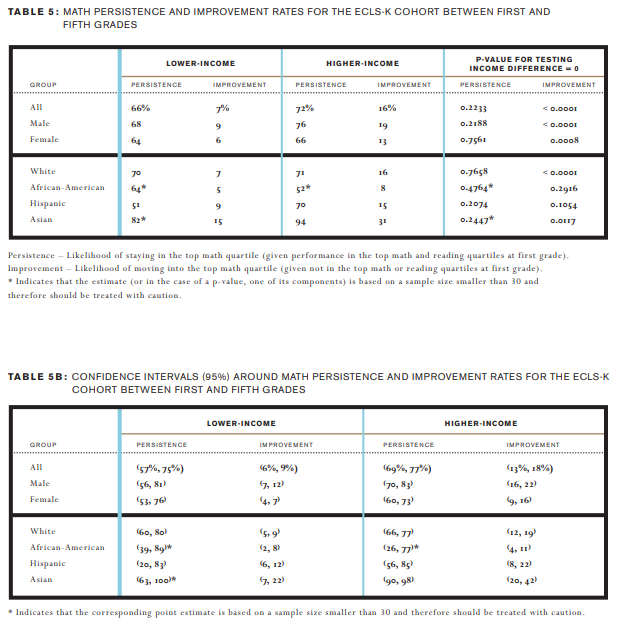
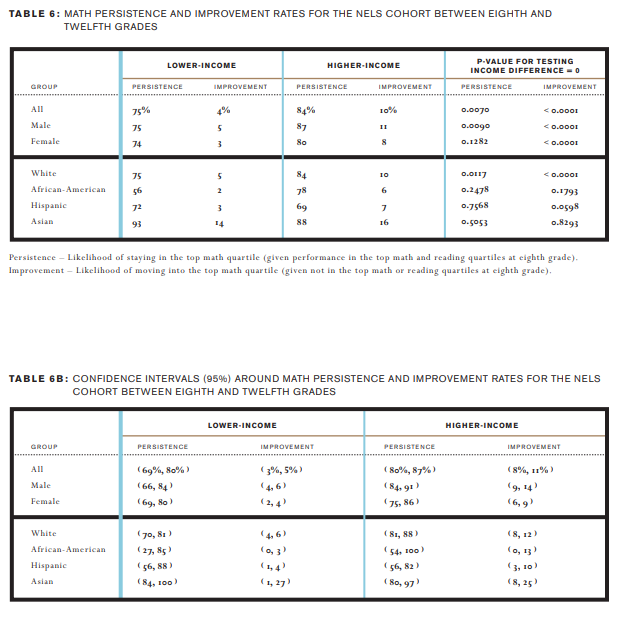
To compute the estimates in Table 7 below, ECLS-K students in the first grade cohort were grouped according to their math performance at first grade, but then assessed based on change in their reading performance. Rates of persistence in the top reading quartile between first and fifth grades were computed for students who were also in the top math quartile at first grade. Using similar logic, rates of improvement into the top reading quartile at fifth grade were computed for students who were in the bottom three math and reading quartiles at first grade. The resulting reading persistence and improvement rates are reasonable estimates of the true rates for each group provided the assumptions stated earlier hold.
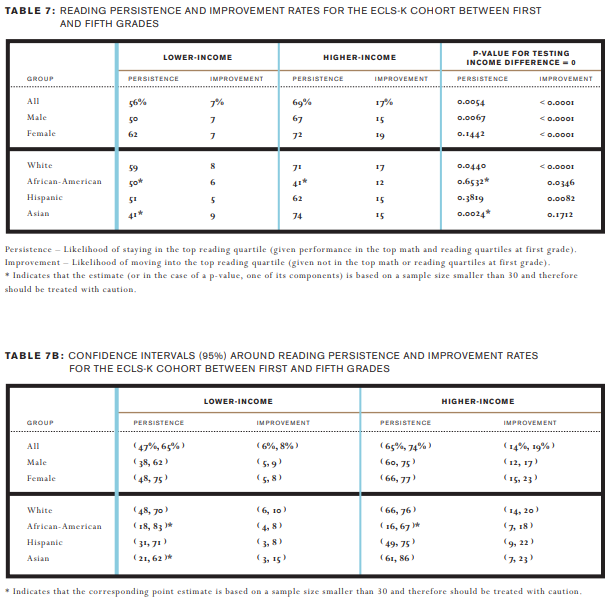
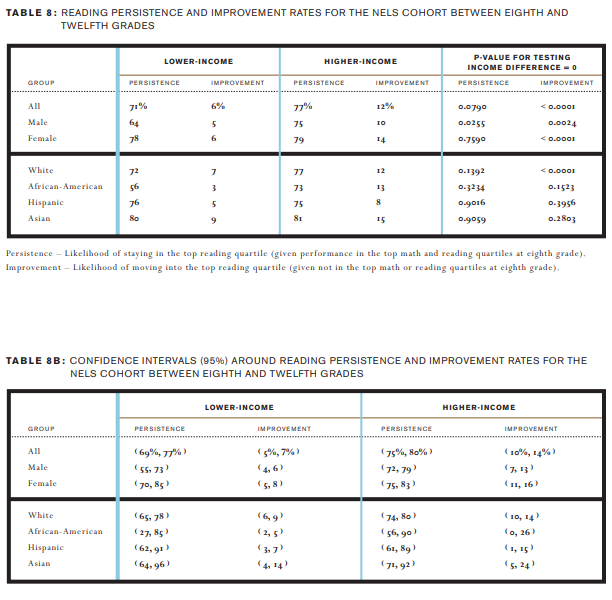
Appendix D: College Entry and Graduation Rates
The analyses of the postsecondary experiences of highachieving twelfth graders are based on data from the National Education Longitudinal Study (NELS) and data from the Baccalaureate and Beyond Longitudinal Study (B&B). The NELS data enable a longitudinal study of the postsecondary experiences through 2000 of twelfth graders from the class of 1992. The B&B data were used for longitudinal analyses of the graduate experiences of 1993 bachelor’s degree recipients through 2003. Results from both surveys are representative of students in the survey base year. In other words, the NELS results are nationally representative of the experiences of a 1992 twelfth grade cohort through 2000; the B&B results are nationally representative of a 1993 cohort of bachelor’s degree recipients through 2003.
What These Data Tell Us about the Postsecondary Experience
It is important to understand that the NELS and B&B offer uniquely different perspectives on the postsecondary experience because of their relationship to the postsecondary pipeline. The NELS data offer a rich representative picture of twelfth graders who enter postsecondary education in the eight years following high school. This measure of entry accommodates the growing number of students who delay entry into postsecondary education. The eight-year duration also enables the analyses to capture the attainment of students who attend postsecondary education on a part-time basis. Both of these factors have grown in importance as relatively fewer students have followed the traditional progression of completing high school and continuing straight through college in four years. It is important to note that the NELS data are representative of a twelfth grade graduating cohort, not a first-year postsecondary education cohort, while the B&B data are representative of a bachelor’s-recipient cohort.
The B&B data offer a representative picture of students leaving four-year institutions who received a bachelor’s degree in 1993. This cohort encompasses a wide demographic and chronological catchment of college-going students. For example, these data are comprised of everyone from the traditional high school graduate who enters college and graduates in four years, to the retiree who decides to return to postsecondary education to obtain a bachelor’s degree after having previously dropped out of school.
Defining High Achievement and Lower-Income
High achievement was defined for the NELS analyses using top quartile performance on survey-administered tests (described in Appendix A) at twelfth grade. For the B&B analyses, it was defined by a combined SAT/ACT quartile measure provided on the B&B data file (SA-TACTQ2). This measure assigns the SAT quartile ranking first and then the ACT quartile ranking in cases where the SAT measure is not valid. While a measure based on SAT/ACT scores may introduce some selection bias because it does not include students who took neither of these tests, this is the best nationally standardized achievement measure available in the B&B data.
Lower-income is defined as the bottom half of the family-size adjusted income distribution, detailed for the NELS in Appendix A. The B&B analyses are based on a definition of adjusted income that uses a composite of independent and dependent family income measures, CINCOME, and the family size variable, SFAMNUM.
Analytic Weights
Analyses of the postsecondary experiences of the NELS cohort were conducted using the weight variable F4F2PNWT, which is appropriate for survey members who responded in 1992, 1994, and 2000. The variable WTC00, was used in the B&B analyses and is the appropriate longitudinal survey weight for respondents to the 1993 and 2003 surveys.
Because the NELS longitudinal weight, F4F2PNWT, led to an over-count of the number of twelfth grade lower-income high achievers, a minor weighting adjustment was made. The NELS longitudinal weight was multiplied by an appropriate scaling factor within racial groups. In essence, this procedure forced the estimate of the number of twelfth grade lower-income high achievers71 based on the longitudinal weight to be consistent with that based on the cross-sectional weight, while accounting for any underlying differences in demographic composition.
B&B Postsecondary Tables
It is important to note that these data are restricted to people who took the SAT or ACT. Roughly 20 percent of the unweighted sample did not take either exam and these students are disproportionately lower-income. However, the data do represent SAT/ACT test-taking history among the 1993 bachelor’s degree recipients. Note that the income measure is a combination of dependent and independent family-size adjusted income.

Endnotes
Note: References in the endnotes are cited in short form. See the bibliography for full citations.
1 See Appendix B, Number of High-Achieving Lower-Income Students in K–12.
2 See Appendix B, Number of High Achievers Eligible for Free or Reduced-Price Lunch.
3 See Appendix B, First Grade Representation by Gender, Urbanicity, and Race.
4 See Appendix B, First Grade Representation by Gender, Urbanicity, and Race. See also Meyers, Analysis of the 1996 Minnesota Basic Standards Test Data; Duncan and Magnuson, “Can Family Socioeconomic Resources Account for Racial and Ethnic Test Score Gaps?” and Gandara, Latino Achievement.
5 See Lee and Burkam, Inequality at the Starting Gate; Duncan and Magnuson, “Can Family Socioeconomic Resources Account for Racial and Ethnic Test Score Gaps?” and Duncan and Brooks-Gunn, Consequences of Growing Up Poor.
6 This estimate derives from the assumption that, absent the mediating effects of poverty on prenatal care and preschool learning, children from each half of the income distribution should more evenly share the top academic quartile in first grade (i.e., low-income high-achieving students should be approximately 50% of first graders in the top academic quartile). Subtracting the observed rate (28%) of low-income students among high achievers from the expected rate (50%), we estimate that 22% of the high-achieving first grade population are low-income students with potential to be high achievers who have not attained top-quartile levels of academic performance. Using 2004 enrollment data, this methodology produces an estimated loss of just over 200,000 students.
7 For evidence on the benefits of high-quality early childhood education, see Gorey, “Early Childhood Education”; Barnett, “Research on the Benefits of Preschool Education”; Greene, “Universal Preschool”; and Schweinhart, Montie, Xiang, Barnett, Belfield, and Nores, “Life-Time Effects.” For research on the availability of high-quality early childhood programs for lower-income children, see Lee and Burkam, Inequality at the Starting Gate; Duncan and Magnuson, “Can Family Socioeconomic Resources Account for Racial and Ethnic Test Score Gaps?” and Duncan and Brooks-Gunn, Consequences of Growing Up Poor.
8 See Appendix A for a discussion of the analytic methodology for evaluating student performance. No nationally representative longitudinal studies currently exist to enable us to examine the achievement patterns of middle school students; however, no existing research demonstrates that the patterns observed in elementary and high school data would be different if middle school data were examined. The US Department of Education will be releasing middle school data from ECLS-K in September 2008, which should provide a bridge between elementary and high school longitudinal data.
9 Before controlling for regression toward the mean, the unadjusted data suggest that 50 percent of high-achieving lower-income students maintain their high achievement status in math during elementary school, compared with 65 percent of high-achieving students from the upper economic half. However, after attempting to control for regression toward the mean, the percentages become 66 and 72 percent, respectively.
10 Specifically, 18 percent of students from the top income quartile who performed in the bottom three academic quartiles in math rose into the top academic quartile during elementary school, while only 6 percent of students from the bottom economic quartile did so.
11 See Bridgeland, DiIulio, and Morison, The Silent Epidemic.
12 But, see Renzulli and Park, “Gifted Dropouts.” Renzulli and Park examine the dropout rates of gifted students, defined broadly as students either participating in a gifted program or taking three or more advanced-level classes. Using nationally representative longitudinal data they find that 48.18% of gifted dropout students were from the lowest quartile of socioeconomic status, while only 3.56% of gifted dropouts were from the top SES quartile.
13 See Appendix D, College Entry and Graduation Rates for a discussion of how “high-achieving” and “lower-income” were defined for postsecondary education.
14 Our analysis of NELS data reveals that 75% of all lower-income twelfth graders and 80% of twelfth graders overall enter some form of postsecondary education.
15 Since 2000, college tuitions have increased by more than 40%. See Lewis, “College Costs.” The College Board reports that the cost of tuition and fees at 4-year public and private institutions rose by an average of 6.1% in the year 2006-2007, and that there has been a 35% increase in inflation-adjusted average tuition and fees for in-state students at public four-year colleges since 2001-2002. See College Board, Trends in Higher Education.
16 See US Department of Education, “Federal Pell Grant.” The maximum Pell Grant available was raised for 2007-2008 to $4,310. See also Tomsho, “As Tuition Soars, Federal Aid to College Students Falls.” In the mid-1970s, a Pell Grant covered about 40% of the cost of tuition at a private 4-year college, while today, it covers just 15%. See Kahlenberg, “Left Behind” and College Board, Trends in Higher Education.
17 See Haycock, “Promise Abandoned” (Education Trust). The report finds that between 1995 and 2003, average institutional grant aid for students from families with incomes between $20,000 and $39,999 increased 32%, while for families making more than $100,000 the amount increased 254%. See also Sallie Mae Fund, “Strengthening Our Commitment to Access.”
18 See Plank and Jordan, “Effects of Information, Guidance, and Actions on Postsecondary Destinations.”
19 Selectivity of an institution was defined according to the first four-year institution that a student attended as of 1994. Students who delayed college entry are not included in this analysis. The selectivity measure is based on the 1997 Barron’s measure. Special schools (art, music, etc) and other unrated schools are not included in the analyses. These data were provided by Anthony Carnevale and were based on his (1998) work on selectivity of schools. See Barron’s Guide to Colleges and Universities for a detailed description of how selectivity is defined. Among the several factors used, selectivity is most closely correlated with the average SAT/ACT scores of entrants.
20 The number of institutions at each level of selectivity measures comes from Barron’s Guide to American Colleges and Universities.
21 While not every student in the top academic quartile can gain admittance to a college in the top level of selectivity, recent analyses demonstrate that many students well-qualified for colleges in the top tier of selectivity nonetheless attend less selective colleges. See Hill and Winston, “How Scarce are High-Ability, Low-Income Students?”
22 A study by the Advisory Committee on Student Financial Assistance found that half of all college-qualified low- and moderate-income high school graduates will be unable to attend four-year colleges because of financial barriers. See Advisory Committee on Student Financial Assistance, “Empty Promises.” See also Sallie Mae Fund, “Strengthening Our Commitment to Access;” Davies and Guppy, “Fields of Study, College Selectivity, and Student Inequalities in Higher Education;” and Mortenson, “The Gated Communities of Higher Education.” achievement trap Endnotes 52
23 See Linnehan, Stonely and Weer, “High School Guidance Counselors.” Other complex academic, social, and cultural factors have been cited as making enrollment in selective schools more challenging for lower-income students than their more affluent peers. See, e.g., Terenzini, et al., “The Transition to College.”
24 See Hoxby, et al., “Cost Should Be No Barrier.” Also see McPherson and Schapiro, Eds., College Access.
25 See the Education Trust reports by Carey, “Choosing to Improve,” and Haycock, “Promise Abandoned.” See also Engle and O’Brien, “Demography Is Not Destiny” (Pell Institute).
26 US Census Bureau, “Current Population Survey, 2006 Annual Social and Economic Supplement.”
27 See Lee and Burkam, Inequality at the Starting Gate. See also Duncan and Magnuson, “Can Family Socioeconomic Resources Account for Racial and Ethnic Test Score Gaps?”
28 See Conger, Conger, and Elder, “Family Economic Hardship and Adolescent Adjustment.”
29 Analysis of NELS 1992 data for this report shows that 75% of all students (regardless of achievement level) from the bottom half of the income distribution attend some form of postsecondary education, compared with 92% of all students from the top income half.
30 For example, projected growth in the next ten years in professional services (28 percent), health care (30 percent), and financial services (10.5 percent) significantly outpaces projections for manufacturing (-5 percent) and mining (-9 percent). See US Department of Labor, “Employment by Major Industry Sector: 1994, 2004 and Projected 2014.”
31 See Goldin and Katz, “The Race between Education and Technology.”
32 For instance, the average annual earnings among African-American males are $53,000 for those with a bachelor’s degree compared to $21,800 for high school graduates and $29,600 for those with some college. For all males, those with a college education earned 87 percent more than those with only high school diplomas in 2004, compared to only 50 percent in 1975. See Economic Report of the President.
33 See Baum and Payea, “Education Pays” (College Board). See also Institute for Higher Education Policy, “The Investment Payoff.”
34 See Education Trust, “The ABCs of AYP.”
35 Recent research suggests that the focus on proficiency leads schools to focus on those students nearest the margin of proficiency, rather than all students, limiting the gains of students at the top and the bottom of the achievement spectrum. See Neal and Schanzenbach, “Left Behind by Design.”
36 Evidence suggests that using curricula designed for gifted students actually benefits the lowest-performing students most. See Swanson, “Breaking Through Assumptions about Low-Income, Minority Gifted Students.”
37 Section 1111 (b)(2)(C) of NCLB requires that student achievement data be disaggregated for racial and ethnic groups, by gender, for students with disabilities, for migrant children, and for students classified as economically disadvantaged, typically defined as students receiving free or reduced-price lunch, provided there are sufficient numbers of students in the category to allow for a statistically valid result. 53
38 This analysis is based on a review of state education department Web sites and contact with state education agencies to locate disaggregated performance data for the 2005-06 and 2004-05 school years. Overall, more disaggregated performance data were available for the 2005-06 school than in previous years. Among states with available data, each state’s standard for measuring advanced performance is different from that used by other states. The following chart provides an example of the variation in the percentages of economically disadvantaged students scoring at advanced reading levels in grade four in 2005-06 as reported by six different states. It does not seem reasonable that economically disadvantaged students in Alabama score at advanced levels at four times the rate of those students in Maryland, or that those in Virginia score at advanced levels at a rate 12.5 times that of students in Massachusetts. Rather, a good part of this variance results from differences in state assessments and in how performance levels are defined.
39 The Thomas Jefferson High School for Science and Technology in Alexandria, Virginia, and the Bronx High School of Science in New York City are two examples of high-performing magnet schools that educate some lower-income students. The Knowledge is Power Program (KIPP) charter schools also have educated thousands of lower-income students across the country, many of whom achieve at advanced levels.
40 While we cannot inventory every one of these programs in the report, several programs worth mentioning include the Goldman Sachs Foundation’s Next Generation Venture Fund, Duke University’s Talent Identification Program, Johns Hopkins University’s Center for Talented Youth, Northwestern University’s Center for Talent Development, the University of Denver’s Rocky Mountain Talent Search, the Jack Kent Cooke Foundation’s Young Scholars Program, the Higher Achievement Program, Prep for Prep, Harvard University’s Crimson Academy, and Princeton University’s Preparatory Program.
41 See Plank and Jordan, “Effects of Information, Guidance, and Actions on Postsecondary Destinations.” See also Linnehan, Stonely and Weer, “High School Guidance Counselors.”
42 Eleven highly selective and state flagship colleges and universities nationwide have over the past two years initiated programs that train recent graduates and place them in high schools with large numbers of low-income students. See, for example, http://www.virginia.edu/cue/guide.html for a description of the initial college guide program.
43 Over the past several years, a number of highly selective public and private colleges and universities have engaged in visible efforts to attract more low-income students by replacing loans with institutional grants and other forms of aid. See, e.g., Hoxby, et al., “Cost Should Be No Barrier: An Evaluation of the First Year of Harvard’s Financial Aid Initiative.” See also, “Duke to Receive $10 Million for its Financial Aid Initiative.”
44 See Dowd, et al., “Transfer Access to Elite Colleges and Universities in the United States.”
45 Two examples of successful programs that help lower-income high achievers excel in college are: (1) the Meyerhoff Scholarship Program at the University of Maryland, Baltimore County, which recruits the nation’s most promising science students, provides them intensive support in learning communities, and sends them to science graduate programs at remarkable rates, and (2) the Posse Foundation, which partners with selective colleges and universities to recruit lowerincome students, assess those students based on broader criteria than are typically used in college admissions, and send them to college in cohorts. For information on the Meyerhoff program see http://www.umbc.edu/meyerhoff/; for information on the Posse Foundation, see http://www.possefoundation.org, Also, see the Questbridge Program (http://www. questbridge.org/index.html).
46 See, for example, the extensive body of work by Dr. Vincent Tinto, Professor and Chair of the Higher Education Program at the School of Education at Syracuse University (CV with a list of published work available at http://soeweb. syr.edu/intranet/secure/UserFiles/File/TINTO_VITA06.pdf), including “Moving From Theory to Action: Building a Model of Institutional Action for Student Success,” National Postsecondary Education Cooperative, Washington, DC: US Department of Education, 2006. See also Engle and O’Brien, “Demography is Not Destiny” (Pell Institute) for an analysis of practices at large public institutions with high graduation rates for low-income students.
47 The US Department of Education requires all private and public postsecondary institutions to report data on the number of students entering the institution full-time for a first-time degree, disaggregated by race/ethnicity and gender but not by income or Pell Grant recipient status. The data are collected and reported through the Integrated Postsecondary Education Data System (IPEDS), http://nces.ed.gov/ipeds. The National Center for Education Statistics also runs a number of large surveys, such as the Beginning Postsecondary Students Longitudinal Study (BPS), but these surveys do not collect institution-specific data. See also Ewell and Boeke, “Critical Connections;” National Center for Higher Education Management Systems, “Harnessing the Potential for Research of Existing Student Records Databases.”
48 See Engle and O’Brien, “Demography is Not Destiny” (Pell Institute) for a discussion of state and institutional policies impacting retention efforts at these institutions and recommendations for improving the availability and use of such retention data for low-income students.
49 See, e.g., Brunner, “Educational Attainment and Economic Status.” See also VanTassel-Baska and Willis, “A Three Year Study of the Effects of Low Income on SAT Scores among the Academically Able”; Klopfenstein, “Advanced Placement”; US Department of Education, The Condition of Education.
50 See Lee and Burkam, Inequality at the Starting Gate.
51 See Lee and Burkam, Inequality at the Starting Gate. See also US Department of Education, The Condition of Education.
52 See VanTassel-Baska and Willis, “A Three-Year Study of the Effects of Low Income on SAT Scores among the Academically Able.”
53 See Klopfenstein, “Advanced Placement.”
54 See Bedsworth, Colby, and Doctor, Reclaiming the American Dream. See also Hebel, “The Graduation Gap”; Advisory Committee on Student Financial Assistance, “Empty Promises”; Haveman and Smeeding, “The Role of Higher Education in Social Mobility”; Muraskin and Lee, “Raising the Graduation Rates of Low Income College Students.”
55 McCall, Hauser, Cronin, Kingsbury, and Houser (2006) examine test data from Northwest Evaluation Association tests of students in grades three through eight. Measuring the summer growth by testing students during the spring and fall of the same calendar year, the study finds that while most students’ scores improve after the summer, those who scored highest in the spring actually had lower scores when re-tested in the fall. While this is found to be true for students from all schools, the summer loss was significantly higher for students from schools with 51%-100% eligibility for free or reduced price lunch than for those in the schools with 0%-25% eligibility. See McCall, et al., Achievement Gaps. 55
56 See Renzulli and Park, “Gifted Dropouts.”
57 See McPherson and Schapiro, Eds., College Access. See also Hoxby, et al., “Cost Should Be No Barrier”; Plank and Jordan, “Effects of Information, Guidance, and Actions on Postsecondary Destinations.”
58 Both the ECLS-K and the NELS assessments used adaptive testing to route individual students to appropriately complex second-stage tests based on earlier performance.
59 For the small number of students having only a reading or mathematics score but not both, the composite was based on the single available test score.
60 Note, however, that the ECLS-K cohort was not freshened to make it nationally representative for third and fifth grades.
61 Attempts were made to test students in the ECLS-K and the NELS regardless of their grade status.
62 See Johnson, Smeeding, and Torrey, “Economic Inequality through the Prisms of Income and Consumption.”
63 See Gray, Hunter, and Taylor, “Health Expenditure, Income and Health Status among Indigenous and Other Australians,” section 3: Comparing Like with Like.
64 See Rose and Hartmann, Still a Man’s Labor Market: The Long-Term Earnings Gap.
65 The past trend data contained in the Projections of Education Statistics provide year-by-grade enrollment data. The private school enrollment data were not useful because they are too highly aggregated. Tom Snyder of NCES provided private school enrollment data for the appropriate years. While these data are based on the Private School Survey, Mr. Snyder had extrapolated several years of the data because the Private School Survey is not fielded every year, and he fully qualified the experimental nature of these data.
66 There were 52,375,000 students enrolled in all grades K-12 in 2004 based on the NCES public and private school enrollment data provided by NCES. Multiplying this enrollment by .065 (the average proportion of students per grade who are high-achieving and from lower-income families) results in 3.4 million.
67 As mentioned in Appendix A, ECLS-K data on family size were derived from information about family composition.
68 See US Department of Health and Human Services, “Prior HHS Poverty Guidelines and Federal Register References.”
69 The distributions do not necessarily sum to 100 percent across categories because students with a missing value for a particular characteristic were included in the denominator of the calculation but not the numerator. Also, the “American Indian, mixed, and other race” category was excluded due to small sample sizes.
70 See, for example, Hanushek and Rivkin (2006), School Quality and the Black-White Achievement Gap, National Bureau of Economic Research Working Paper 12651. Available at http://www.nber.org/papers/w12651.
71 Use of the twelfth grade cross-sectional weight (F2QWT) produced an estimated population of approximately 165,000 lower-income high achievers while the longitudinal weight (F4F2PNWT) led to an estimate of 173,000. This finding is not surprising because non-response adjustments due to attrition would not have been targeted toward preserving estimates of lower-income high achievers.
Bibliography
Ad Council, “College Access: Results from a Survey of Low-Income Parents and Low-Income Teens.” (2006), http://www.strivetogether.org/documents/adcouncil.pdf (accessed July 26, 2007).
Adam, M. “Re-Claiming an Old Social Contract: College for Low-Income Students.” Education Digest 72, No. 7: (2007).
Advisory Committee on Student Financial Assistance. Empty Promises: The Myth of College Access in America. A Report of the Advisory Committee on Student Financial Assistance, Washington, DC: (2002).
Ainsworth-Darnell, J. W. and D. B. Downey. “Assessing the Oppositional Culture Explanation for Racial/Ethnic Differences in School Performance.” American Sociological Review 63 (1998): 536-53.
Alexander, K. L., Pallas, A. M., and S. Holupka. “Consistency and Change in Educational Stratification: Recent Trends Regarding Social Background and College Access.” Research in Social Stratification and Mobility 6 (1987): 161-85.
Ambrose, D. “Barriers to Aspiration Development and Self-Fulfillment: Interdisciplinary Insights for Talent Discovery.” Gifted Child Quarterly 47 (2003): 282-94.
Andrews, W. “A World Of Posse-bilities.” (CBS News.com, 2007), http://www.cbsnews.com/blogs/2007/06/05/couricandco/ entry2887049.shtml, (accessed July 26, 2007).
Astin, A. W. The Myth of Equal Success in Public Higher Education. Atlanta: Southern Education Foundation, 1975.
Baker, B. D. and R. Friedman-Nimz. “State Policies and Equal Opportunity: The Example of Gifted Education.” Educational Evaluation and Policy Analysis 26 (2004): 39-64.
Baldwin, A.Y. “The Seven Plus Story: Developing Hidden Talent Among Students in Socioeconomic Disadvantaged Environments.” Gifted Child Quarterly 38 (1994): 80-84.
Balfanz, R. and N. Legters. Locating the Dropout Crisis: Which High Schools Produce the Nation’s Dropouts? Where Are They Located? Who Attends Them? (Center for Research on the Education of Students Placed at Risk at Johns Hopkins University, 2004), http://www.csos.ihu.edu (accessed July 26, 2007).
Barnett, W. S. “Research on the Benefits of Preschool Education: Securing High Returns of Preschool for All Children.” (National Institute for Early Education Research, 2007), http://nieer.org/ resources/files/Benefits.pdf (accessed July 26, 2007).
Barron’s Guide to Colleges and Universities. Hauppage, NY: Barron’s Education Series, Inc., 1994-2001.
Baum, S. and K. Payea. “Education Pays: The Benefits of Higher Education for Individuals and Society.” (Part of the College Board Trends in Higher Education Series, 2004, rev. 2005), http://www.collegeboard.com/prod_downloads/press/cost04/ EducationPays2004.pdf (accessed July 26, 2007).
Baum, S. M., Renzulli, J. S., and T. P. Hebert. “Reversing Underachievement: Creative Productivity as a Systematic Intervention.” Roeper Review 39 (1995): 224-35.
Baum, S. and S. Owen. “Talent Beyond Words: Identification of Potential Talent in Dance and Music in Elementary Students.” In Zimmerman, E. (Ed.) Artistically and Musically Talented Students (pp. 57-72.) Thousand Oaks, CA: Corwin Press, 2004.
Bedsworth, W., Colby, S., and J. Doctor. Reclaiming the American Dream. (The Bridgespan Group, Inc., 2006), http://www.bridgespangroup.org (accessed July 26, 2007).
Benbow, C. P. and J. C. Stanley. “Intellectually Talented Students: Family Profiles.” Gifted Child Quarterly 24 (1980): 119-22.
Benbow, C. P. and O. Arimand. “Predictors of High Academic Achievement in Mathematics and Science by Mathematically Talented Students: A Longitudinal Study.” Journal of Educational Psychology, 82 (1990).
Bere, M. “New Studies in Education: The Mental Capacity of Children of Foreign Parentage.” Teachers College Record, Volume 28, Number 2 (1926): 200-02.
Berg, P. and M. Singer. Dealing with Genes: The Language of Heredity. Mill Valley, CA: University Science Books, 1992.
Best, J. Benjamin Franklin on Education. Richmond, VA: William Byrd Press, Inc., 1962.
Boothe, D. and J. C. Stanley, (Eds.). In the Eyes of the Beholder: Critical Issues for Diversity in Gifted Education. Waco, TX: Prufrock Press, 2004.
Borland, J. Issues and Practices in the Identification and Education of Gifted Students from Underrepresented Groups. Storrs, CT: University of Connecticut, National Research Center on the Gifted and Talented NRCGT, 2004. Borland, J. H., Schnur, R., and L. Wright. “Economically Disadvantaged Students in a School for the Academically Gifted: A Postpositivist Inquiry into Individual and Family Adjustment.” Gifted Child Quarterly 44 (2000): 13-32.
Bowen, W. G., Kurzweil, M. A., and E. M. Tobin. Equity and Excellence in American Higher Education. University of Virginia Press, 2005.
Brewer, E. “A Longitudinal Study of the Talent Search Program.” Journal of Career Development, 31 (2005): 195-208.
Bridgeland, J. M., DiIulio, J. J. and K. B. Morison. The Silent Epidemic: Perspectives of High School Dropouts. Civic Enterprises and Peter D. Hart Research Associates. For the Bill and Melinda Gates Foundation, 2006.
Brint, S. and J. Karabel. The Diverted Dream: Community Colleges and the Promise of Educational Opportunity in America 1900-1985. Oxford University Press, 1989.
Brooks-Gunn, J., Guo, G., and E. F. Furstenberg, Jr. “Who Drops Out of and Who Continues Beyond High School? A 20 Year Study of Black Youth.” Journal of Research in Adolescence 37 (1993): 271-94.
Brunner, E. D. “Educational Attainment and Economic Status.” Teachers College Record, Vol. 49, No. 4 (1948): 242-49.
Burney, V. H. and T. L. Cross. “Impoverished Students with Academic Promise in Rural Settings: 10 Lessons from Project Aspire” Gifted Child Today 29 (2006): 14-21.
Cabrera, A. F., Burkum, K. R. and S. M. La Nasa, “Pathways to a Four-Year Degree: Determinants of Degree Completion Among Socio-Economically Disadvantaged Students.” Washington, DC: US Department of Education, 2003.
Callahan, C. M. “Identifying Gifted Students from Underrepresented Populations.” Theory into Practice 44 (2005): 98-105.
Campbell, F. A. and C. T. Ramey. “The Relationship Between the Piagetian Cognitive Development, Mental Test Performance, and Academic Achievement in High-Risk Students With and Without Early Educational Experience.” Intelligence, 14 (1990): 293-308.
Cancro, R., Ed. Intelligence: Genetic and Environmental Influences. New York: Grone & Stratton, 1971.
Canivez, G. L. and T. R. Konold. “Assessing Differential Prediction Bias in the Developing Cognitive Abilities Test Across Gender, Race/Ethnicity, and Socioeconomic Groups.” Educational and Psychological Measurement, 61 (2001): 159-71.
Carey, K. “Choosing to Improve: Voices from Colleges and Universities with Better Graduation Rates.” (Education Trust, 2005), http://www2.edtrust.org/NR/rdonlyres/40EEF8D0- 1257-48C2-8622-10AEB8988727/0/Choosing_to_improve.pdf (accessed July 26, 2007).
Castellano, J. A., and E. I. Diaz (Eds.). Reaching New Horizons: Gifted and Talented Education for Culturally and Linguistically Diverse Students. Boston, MA: Allyn & Bacon, 2002.
Choi, K., et al. Children Left Behind in A YP and Non-A YP Schools: Using Student Progress and the Distribution of Student Gains to Validate A YP. Center for the Study of Evaluation, National Center for Research on Evaluation, Standards, and Student Testing, UCLA CSE Report 637 (2004).
Chow, K. “Univ. to Aid Low-Income Students.” Yale Daily News (January 18, 2007).
Colangelo, N., Assouline, S. G., and M. U. M. Gross. A Nation Deceived: How Schools Hold Back America’s Brightest Students. The Connie Belin & Jacqueline N. Blank International Center for Gifted Education and Talent Development, and the Templeton Foundation (2004).
Coleman, L. “Talent Development in Economically Disadvantaged Populations.” Gifted Child Today 29 (2006): 22-27.
Coleman, M. R. and J. J. Gallagher. “State Identification Policies: Gifted Students from Special Populations.” Roeper Review, 17 (1995): 268-75.
College Board. Trends in Higher Education. (College Board, 2006), http://www.collegeboard.com/prod_downloads/press/cost06/ trends_college_pricing_06.pdf (accessed July 26, 2007).
Cone, J. K. Untracking Advanced Placement English: Creating Opportunity is Not Enough. National Writing Project: Occasional Paper No. 30 (1992).
Conger, R. D., Conger, K. J., and G. H. Elder, Jr. “Family Economic Hardship and Adolescent Adjustment: Mediating and Moderating Processes.” In Duncan, G. J. and J. BrooksGunn, Eds., Consequences of Growing Up Poor. New York: Russell Sage Foundation, 1997.
Cross, T. and V. H. Burney. “High Ability, Rural, and Poor: Lessons from Project Aspire and Implications for School Counselors.” Journal of Secondary Gifted Education 16 (2005): 148-56. Cross, T., Coleman, L., and R. Stewart. “The Social Cognition of Gifted Adolescents in Schools: Managing the Stigma of Giftedness.” Journal for the Education of the Gifted 15 (1993): 44-55.
Cunningham, A., Redmond, C., and J. Merisotis. Investing Early: Intervention Programs in Selected US States. Montreal: Institute for Higher Education Policy, 2003.
Davies, S. and N. Guppy. “Fields of Study, College Selectivity, and Student Inequalities in Higher Education.” Social Forces 75 (1997): 1417.
Davis, H. “Self-Concept Profiles of Gifted Underachievers.” (Doctoral dissertation, University of Rochester, 1983). Dissertation Abstracts International, 45 (1984): 1072. (University Microfilms International No. AAC84-13056).
Dewey, J. Democracy and Education. New York, NY: The Macmillan Company, 1916.
Dougherty, K. “The Effects of Community Colleges: Aid or Hindrance to Socioeconomic Attainment?” Sociology of Education 60 (1987): 86-103.
Dowd, A., et al. “Transfer Access to Elite Colleges and Universities in the United States: Threading the Needle of the American Dream.” (Jack Kent Cooke Foundation, 2006), http://www. jackkentcookefoundation.org/jkcf_web/Documents/ Exe%20Summ%20Final.pdf (accessed July 27, 2007).
“Duke to Receive $10 Million for its Financial Aid Initiative.” (Duke News, 2007), http://www.dukenews.duke.edu/2007/02/ financialaid_gift.html (accessed July 27, 2007).
Duncan, G. J. and K. A. Magnuson. “Can Family Socioeconomic Resources Account for Racial and Ethnic Test Score Gaps?” The Future of Children 15 (2005): 35-54.
Duncan, G. J., Brooks-Gunn, J., and P. K. Klebanov, “Economic Deprivation and Early-Childhood Development.” Child Development 65 (1994): 296-318.
Eby, J. W. “Gifted Behavior: A Nonelitist Approach.” Educational Leadership 41 (1983): 30-36.
Eccles, J. S. and A. Wigfield. “Students’ Motivation During the Middle School Years.” In J. Aronson (Ed.), Improving Academic Achievement: Impact of Psychological Factors on Education. New York: Academic Press, 2002.
Eccles, J. S. “Schools, Academic Motivation, and Stage-Environment Fit.” In R.M. Lerner & L. Steinberg (Eds.), Handbook of Adolescent Psychology, 2nd Edition. Hoboken, NJ: Wiley, 2004.
Economic Report of the President. Washington, DC: US Government Printing Office, 2007.
Education Trust. “The ABCs of AYP.” (2004), http://www2.edtrust.org/NR/rdonlyres/37B8652D-84F4- 4FA1-AA8D-319EAD5A6D89/0/ABCAYP.PDF (accessed July 26, 2007).
Education Trust. The Funding Gap 2005: Low-Income and Minority Students Shortchanged by Most States. Washington, DC: Author, 2005.
Ekstrom, R. B., Goertz, M. E., Pollack, J. M. and D. A. Rock, “Who Drops Out of High School and Why? Findings from a National Study.” Teachers College Record 87 (1986): 356-73.
Engle, J. “Postsecondary Access and Success for First-Generation College Students.” American Academic Volume 3: 25-48.
Engle, J. and C. O’Brien. “Demography is Not Destiny: Increasing the Graduation Rates of Low-Income College Students at Large Public Universities.” Washington, DC: The Pell Institute, 2007.
Epstein, D. “It Takes a Counselor, Not a Village.” Inside Higher Ed 5 (2005), http://insidehighered.com/news/2005/07/05/aid (accessed July 26, 2007).
Evans, C. “A Culture of Hard Work and Determination Pays Off.” New Jersey Times (June 11, 2007).
Ewell, P. and M. Brooks. “Critical Connections: Linking States’ Unit Record Systems to Track Student Progress.” Boulder, CO: National Center for Higher Education Management Systems and the Lumina Foundation for Education, 2007.
Farah, M. and K. G. Noble, “Socioeconomic Influences on Brain Development: A Preliminary Study.” in Developing Individuality in the Human Brain: A Tribute to Michael Posner, E. Awh, U. Mayr, and S. Keele, Eds. Washington: American Psychological Association, 2005.
“Federal Pell Grant.” (Student Aid on the Web, 2007), http://studentaid.ed.gov/PORTALSWebApp/students/english/ PellGrants.jsp?tab=funding (accessed July 27, 2007).
Fischer, K. “Elite Colleges Lag in Serving the Needy.” The Chronicle of Higher Education 52 (2006): Available at: http://chronicle.com/ free/v52/i36/36a00101.htm (accessed July 26, 2007).
Fisher, R. Classical Utopian Theories of Education. New Haven, CT: College & University Press, 1963.
Ford, D. Y., Baytops, J. L., and D. A. Harmon. “Helping Gifted Minority Students Reach Their Potential: Recommendations for Change.” Peabody Journal of Education, 72 (1997): 201-16.
Forsbach, T. “Factors Related to the Identification of Minority Gifted Children.” Paper Presented at Annual Conference of the American Education Research Association, 1999.
Frasier, M. “Issues, Problems and Programs in Nurturing the Disadvantaged and Culturally Different Talented.” In K. A. Heller & F. J. Monks et al. (Eds.), International Handbook of Research and Development of Giftedness and Talent. (pp. 685-92). Elmsford, NY: Pergamon Press, Inc., 1993.
Frasier, M. “Disadvantaged and Culturally Diverse Gifted Students.” Journal for the Education of the Gifted 14 (1991): 234-45.
Frasier, M., Hunsaker, S. L., Lee, J., Finley, V. S., Frank, E., and J. H. Garcia. Educators’ Perceptions of Barriers to the Identification of Gifted Children from Economically Disadvantaged and Limited English Proficient Backgrounds. (Report RM-95216). Storrs, CT: University of Connecticut, National Research Center on the Gifted and Talented, 1995.
Frey, C. “UW Promises 5600 Full Scholarships for Needy Students.” (Seattle Post-Intelligencer, June 5, 2007), http://seattlepi.nwsource.com/local/318433_huskypromise05. html?source=mypi (accessed July 26, 2007).
Gandara, P. Fragile Futures: Risk and Vulnerability Among Latino High Achievers. (Educational Testing Service (ETS) Policy Evaluation and Research Center, 2005), www.ets.orq/Media/Research/pdf/ PICFRAGFUT.pdf (accessed July 26, 2007).
Gandara, P. Latino Achievement: Identifying Models That Foster Success. University of California Latino/Latina Policy Research Program (RM04194). Storrs, CT: University of Connecticut, National Research Center on the Gifted and Talented, 2004.
Gerald, D. and K. Haycock. “Engines of Inequality: Diminishing Equity in the Nation’s Premier Public Universities.” (The Education Trust, 2007), http://www2.edtrust.org/NR/ rdonlyres/F755E80E-9431-45AF-B28E-653C612D503D/0/ EnginesofInequality.pdf (accessed July 26, 2007).
“Gifted Education.” (The Online NewsHour, 2004), http://www.pbs.org/newshour/bb/education/jan-june04/ education_05-25.html (accessed July 26, 2007).
Goldin, C. and L. F. Katz. “The Race Between Education and Technology: The Evolution of US Educational Wage Differentials, 1890 to 2005.” (NBER Working Paper No. 12984, 2007), http://www.nber.org/papers/w12984 (accessed July 26, 2007).
Goldin, C. “America’s Graduation from High School: The Evolution and Spread of Secondary Schooling in the Twentieth Century.” The Journal of Economic History 58 (1998): 345-74.
Good, C., Aronson, J., and M. Inzlicht. “Improving Adolescents’ Standardized Test Performance: An Intervention to Reduce the Effects of Stereotype Threat.” Journal of Applied Developmental Psychology 24 (2003): 645-62.
Gordon, E. W, et al. All Students Reaching the Top. Report of the National Study Group for the Affirmative Development of Academic Ability, Naperville, IL: Learning Point Associates, 2004.
Gorey, K. M. “Early Childhood Education: A Meta-analytic Affirmation of the Short- and Long-Term Benefits of Educational Opportunity.” School Psychology Quarterly 16 (2001): 9-30.
Gottfried, A. W., Gottfried, A. E., Bathurst, K., Guerin, D.W., and M. M. Parramore, “Socioeconomic Status in Children’s Development and Family Environment: Infancy through Adolescence.” In M. H. Bornstein and R. H. Bradley, Eds., Socioeconomic Status, Parenting and Child Development, Mahwah, NJ: Lawrence Erlbaum Associates, 2002.
Gray, M. C., Hunter, B. H., and J. Taylor. “Health Expenditure, Income and Health Status among Indigenous and Other Australians.” (Australia National University E Press, 2004), http://epress.anu.edu.au/caepr_series/no_21/mobile_devices/ index.html (accessed July 27, 2007).
Greene, W. “Universal Preschool: A Costly but Worthy Goal.” Journal of Law & Education 35 (2006): 555-63.
Gregory, S. T., Ed. The Academic Achievement of Minority Students: Perspectives, Practices, and Prescriptions. Lanham, MD: University Press of America, 2000.
Griffith, J. “The Relation of School Structure and Social Environment to Parent Involvement in Elementary Schools.” The Elementary School Journal 99 (1998): 53-81.
Hamre, B. R. and R. C. Pianta, “Early Teacher-Child Relationships and the Trajectory of Children’s School Outcomes through Eighth Grade.” Child Development 72 (200l): 625-88.
Hanushek, E. A. and S. G. Rivkin. School Quality and the BlackWhite Achievement Gap. Cambridge, MA: Working paper 12651 of the National Bureau of Economic Research, 2006.
Harden, K., Turkheimer, E., and J. Loehlin. Genotype by Environment Interaction in Adolescents’ Cognitive Aptitude. Behavior Genetics 37 (2007): 273-83.
Harmon, D. “They Won’t Teach Me: The Voices of Gifted African American Inner-City Students.” Roeper Review 24 (2002): 68-75.
Haveman, R. and T. Smeeding. “The Role of Higher Education in Social Mobility.” The Future of Children 16 (2006): 125-50.
Haycock, K. “Promise Abandoned: How Policy Choices and Institutional Practices Restrict College Opportunities.” (Education Trust, 2006), http://www2.edtrust.org/NR/rdonlyres/ B6772F1A-116D-4827-A326-F8CFAD33975A/0/ PromiseAbandonedHigherEd.pdf (accessed July 26, 2007).
Hebel, S. “The Graduation Gap.” The Chronicle of Higher Education 53 (2007).
Hébert, T. P. “Educating Gifted Children from Low Socioeconomic Backgrounds: Creating Visions of a Hopeful Future.” Exceptionality 10 (2002): 127-38.
Hébert, T. P. and T. M. Beardsley. “Jermaine: A Critical Case Study of a Gifted Black Child Living in Rural Poverty.” Gifted Child Quarterly 45 (2001): 85-103.
Hecht, S. A., Burgess, S, R., Torgesen, J. K., Wagner, R. K., and C. A. Rashotte, “Explaining Social Class Differences in Growth of Reading Skills from Beginning Kindergarten through Fourth Grade: The Role of Phonological Awareness, Rate of Access, and Print Knowledge.” Reading and Writing 12 (2000).
Heckman, J. and A. B. Krueger, Inequality in America. Cambridge, MA: MIT Press, 2004.
Hemmings, A. “Conflicting Images? Being Black and a Model High School Student.” Anthropology & Education Quarterly 27 (1996): 20-50.
Henchey, N. “Schools That Make a Difference: Final Report. Twelve Canadian Secondary Schools in Low-Income Settings.” Society for the Advancement of Excellence in Education, 2001.
Henderson, L. M. and F. F. Ebner. “The Biological Basis for Early Intervention with Gifted Children.” Peabody Journal of Education 72 (1997): 59-80.
Hill, C. and G. Winston. “How Scarce are High-Ability, LowIncome Students?” In M. S. McPherson and M. O. Schapiro, Eds. College Access: Opportunity or Privilege? New York: The College Board, 2006.
Hoffer, T. B., Rasinski, K. A., and W. Moore. “Social Background Differences in High School Mathematics and Science Coursetaking and Achievement.” US Department of Education Office of Educational Research and Improvement (NCES 95-206), 1995.
Horn, L. and C. Xianglei. “Toward Resiliency: At-Risk Students Who Make it to College.” Washington, DC: US Department of Education, Office of Educational Research and Improvement, 1998.
Hoxby, C., Avery, C., Jackson, C., Burek, K., Pope, G., and M. Raman. “Cost Should be No Barrier: An Evaluation of the First Year of Harvard’s Financial Aid Initiative.” (National Bureau of Economic Research, 2006), http://www.nber.org/papers/w12029 (accessed July 26, 2007).
Hunsaker, S. “Family Influences on the Achievement of Economically Disadvantaged Students: Implications for Gifted Identification and Programming.” Research Monograph 95206. Storrs, CT: University of Connecticut, 1995.
Hunsaker, S. “An Analysis of Teacher Nominations and Student Performance in Gifted Programs.” Gifted Child Quarterly 41 (1997): 19-24.
Institute for Higher Education Policy. “The Investment Payoff: A 50-State Analysis of the Public and Private Benefits of Higher Education.” (IHEP, 2005), http://www.ihep.org/Pubs/PDF/ InvestmentPayoff2005.pdf (accessed July 27, 2007).
Irvine, D. J. “What Research Doesn’t Show about Gifted Dropouts.” Educational Leadership 44 (1987): 79-80.
Jackson, P. “Higher Education Tax Credits: An Economic Analysis.” CRS Report for Congress (February 20, 2007).
Jacoby, R. and N. Glauberman, Eds. The Bell Curve Debate. New York, NY: Times Books, 1995.
Jatko, B. P. “Action Research and Practical Inquiry: Using a Whole Class Tryout Procedure for Identifying Economically Disadvantaged Students in Three Socioeconomically Diverse Schools.” Journal for the Education of the Gifted 19 (1995): 83-105.
Jesse, D., Davis, A., and N. Pokorny. “High-Achieving Middle Schools for Latino Students in Poverty.” Journal of Education for Students Placed at Risk 9 (2004): 23-45.
Jimerson, S. R., Egeland, B., and L. A. Sroufe. “A Prospective Longitudinal Study of High School Dropouts: Examining Multiple Predictors across Development.” Journal of School Psychology 38 (2000): 525-49.
Johnsen, S. and G. Ryser. “Identification of Young Gifted Children from Lower-Income Families.” Gifted and Talented International 9 (1994): 62-68.
Johnson, D. S., Smeeding, T., and B. Boyle Torrey. “Economic Inequality through the Prisms of Income and Consumption.” Monthly Labor Review (2005): 11-24.
Johnson, S. T. “Extra-School Factors in Achievement, Attainment, and Aspiration among Junior and Senior High School-Age African American Youth.” Journal of Negro Education 54 (1992): 416-30.
Jordan, W. J. and S. B. Plank. “Talent Loss Among High-Achieving Poor Students”, in Schooling Students Placed at Risk: Research, Policy, and Practice in the Education of Poor and Minority Adolescents, M. G. Sanders, Ed. Florence, KY: Lawrence Erlbaum Associates, Inc., 2000.
Kahlenberg, R. D. “Left Behind: Unequal Opportunity in Higher Education.” New York: The Century Foundation, 2004.
Kahlenberg, R. D. America’s Untapped Resource: Low-Income Students in Higher Education. Washington, DC: The Century Foundation Press, 2004.
Kelly, P. “As America Becomes More Diverse: The Impact of State Higher Education Inequality.” (National Center for Higher Education Management Systems, 2005), http://www.nchems. org/pubs/docs/Inequality%20Paper%20Jan2006.pdf (accessed July 26, 2007).
Kitano, M. K. and R. B. Lewis. “Examining the Relationships between Reading Achievement and Tutoring Duration and Content for Gifted Culturally and Linguistically Diverse Students from Low-Income Backgrounds.” Journal for the Education of the Gifted 30 (2007 ): 295-325.
Klopfenstein, K. “Advanced Placement: Do Minorities Have Equal Opportunity?” Economics of Education Review 23 (2004): 115-31.
Konstantopoulos, S., Modi, M., and L. V. Hedges. “Who Are America’s Gifted?” American Journal of Education 109 (2001): 344-82.
Lagemann, E. Jane Addams on Education. New York, NY: Teachers College Press, 1985.
Lajoie, S. P. and B. M. Shore. “Three Myths? The Overrepresentation of the Gifted Among Dropouts, Delinquents, and Suicides.” Gifted Child Quarterly 25 (1981).
“Large Numbers of Highly Qualified, Low-Income Students Are Not Applying to Harvard and Other Highly Selective Schools.” Journals of Blacks in Higher Education, (2006).
Lee, V. E. and D. T. Burkam. Inequality at the Starting Gate: Social Background Differences in Achievement as Children Begin School. Washington, DC: Economic Policy Institute, 2002.
Levine, D. U., Lachowicz, H., Oxma, K., and A. Tangeman. “The Home Environment of Students in a High-achieving InnerCity Parochial School and a Nearby Public School.” Sociology of Education 45 (1972): 435-45.
Lewis, A. C. “College Costs.” The Education Digest 72 (2006).
Linnehan, F., Stonely, P., and C. Weer. “High School Guidance Counselors: Facilitators or Preemptors of Social Stratification in Education?” (Drexel University, National Commission for Cooperative Education: Manuscript of presentation at Academy of Management conference, 2006), http://www.collegeaccess. org/NCAN/Uploads/2006095102MANUSCRIPT-counselor.doc (accessed July 26, 2007).
Lohman, D. F. “Understanding and Predicting Regression Effects in the Identification of Academically Gifted Children.” Paper presented at AERA, 2006.
Lubinski, D. and L. G. Humphreys. “Some Bodily and Medical Correlates of Mathematical Giftedness and Commensurate Levels of Socioeconomic Status.” Intelligence 16 (1992): 99-116.
Lucas, S. R. and M. Berends. “Sociodemographic Diversity, Correlated Achievement, and De Facto Tracking.” Sociology of Education 75 (2002): 328-48.
Lundy, G. F. and G. Firebaugh. “Peer Relations and School Resistance in American High Schools: Does Oppositional Culture Apply to Race or to Gender?” Paper presented at the annual meeting of the American Sociological Association, Washington, DC, 2000.
Mantzicopoulos, P. Y. “Can the Brigance K & 1 Screen Detect Cognitive/Academic Giftedness When Used with Preschoolers from Economically Disadvantaged Backgrounds?” Roeper Review 22 (2000): 185-91.
“Many Low-Income Blacks Cannot Afford Higher Education at State-Operated Schools.” The Journal of Blacks in Higher Education 35 (2002): 30.
Mare, R. D. “Social Background and School Continuation Decisions.” Journal of the American Statistical Association 75 (1980): 295-305.
Martineau, K. “Yale’s Other Class.” Hartford Courant. June 10, 2007, http://www.courant.com/news/education/ hc-yaleclass0610.artjun10,0,2002014.story?coll=hc-bigheadlines-breaking (accessed July 26, 2007).
Mayer, S. E. How Economic Segregation Affects Children’s Educational Attainment. Social Forces 18 (2002): 153-76.
McCall, M. S., et al. Achievement Gaps: An Examination of Differences in Student Achievement and Growth. (Northwest Evaluation Association, 2006), http://www.nwea.org/research/national.asp (accessed July 26, 2007).
McKenna, M. A., Hollingsworth, P. L., and L. B. Barnes. “Developing Latent Mathematics Abilities in Economically Disadvantaged Students.” Roeper Review 27 (2005): 222-27.
McPherson, M. S. and M. O. Schapiro, Eds. College Access: Opportunity or Privilege? New York: The College Board, 2006.
Meyers, S. L. Analysis of the 1996 Minnesota Basic Standards Test Data. Minneapolis, MN: University of Minnesota, Hubert H. Humphrey Institute of Public Affairs, 1997.
Mills, C. J., Stork, E. J., and D. Krug. “Recognition and Development of Academic Talent in Educationally Disadvantaged Students.” Exceptionality 3 (1992): 165-80.
Mitchell, B. “Nurturing the Low-Income Child: Selected Vignettes from Project Hunches.” Gifted Child Today 9 (1986): 30-32.
Moon, T. R. and C. M. Callahan. “Curricular Modifications, Family Outreach, and a Mentoring Program.” Journal for the Education of the Gifted 24 (2001): 305-21.
Morgan, S. L. “Counterfactuals, Causal Effect Heterogeneity, and the Catholic School Effect on Learning.” Sociology of Education 74 (2001): 341-74.
Mortenson, T. G. “The Gated Communities of Higher Education: 50 Most Exclusive Public and Private 4-Year Institutions FY1994- FY2005.” Postsecondary Education Opportunity, No. 177 (2007).
Muraskin, L. and J. Lee. Raising the Graduation Rates of Low-Income College Students. Washington, DC: Pell Institute for the Study of Opportunity in Higher Education, 2004.
Murray, C. “IQ and Economic Success.” Public Interest 128 (1997): 21-35.
Naglieri, J. A. and D. Y. Ford. “Addressing Underrepresentation of Gifted Minority Children Using the Naglieri Nonverbal Ability Test (NNAT).” Gifted Child Quarterly 47 (2003): 155-61.
National Center for Higher Education Management Systems (2005): “Harnessing the Potential for Research of Existing Student Records Databases: An Action Agenda.” (2005), http://www.nchems.org/c2sp (accessed July 26, 2007).
Neal, D. and D. Schanzenbach. “Left Behind by Design: Proficiency Counts and Test-Based Accountability.” (American Enterprise Institute, 2007), http://www.aei.org/docLib/20070716_NealSchanzenbachPaper.pdf (accessed July 27, 2007).
Noble, K., Farah, M., and B. M. McCandliss. “The Effects of Socioeconomic Status and Phonological Awareness on Reading Development.” Paper presented to the Society for the Scientific Study of Reading, Amsterdam, The Netherlands, 2004.
O’Connor, C. “Dispositions toward (Collective) Struggle and Educational Resilience in the Inner City: A Case Analysis of Six African-American High School Students.” American Educational Research Journal 34 (1997): 593-629.
Olszewski-Kubilius, P. “Addressing the Achievement Gap Between Minority and Nonminority Children: Increasing Access and Achievement through Project EXCITE.” Gifted Child Today 29 (2006): 28-37.
Olszewski-Kubilius, P. and L. Laubscher. “The Impact of a College-Counseling Program on Economically Disadvantaged Gifted Students and their Subsequent College Adjustment.” Roeper Review 18 (1996): 202-08.
Olszewski-Kubilius, P., Grant, B., and C. Seibert. “Social Support Systems and the Disadvantaged Gifted: A Framework for Developing Programs and Services.” Roeper Review 17 (1994): 20-25.
Parker, W. D. “Birth-Order Effects in the Academically Talented.” Gifted Child Quarterly 42 (1998): 29-38.
Paulsen, M. B. and E. P. St. John. “Social Class and College Costs: Examining the Financial Nexus between College Choice and Persistence,” The Journal of Higher Education 73 (2002): 189-236.
Peske, H. and K. Haycock. Teaching Inequality. Washington, DC: The Education Trust, 2006.
Phillips, M. and T. Chen. “School Inequality: What Do We Know?” (School of Public Policy and Social Research, UCLA, 2003), http://www.russellsage.org/programs/main/ inequality/050516.461131 (accessed July 26, 2007).
Plank, S. B. and W. J. Jordan. “Effects of Information, Guidance, and Actions on Postsecondary Destinations: A Study of Talent Loss.” American Educational Research Journal 38 (2001): 947-79.
Plucker, J., Callahan, C., and E. Tomchin. “Wherefore Art Thou, Multiple Intelligences? Alternative Assessments for Identifying Talent in Ethnically Diverse and Low-Income Students.” In Sternberg, R. (Ed.) Definitions and Conceptions of Giftedness. Thousand Oaks, CA: Corwin Press, 2004.
Posner, J. “Variations in Low-Income Children’s Use of Time after School.” Washington, DC: Paper presented at the biennial meeting of the Society for Research in Child Development, 1997.
Posner, J. and D. Vandell. “Low-Income Children’s After School Care: Are There Beneficial Effects of After School Programs?” Child Development 65 (1994): 440-56.
Reid, C., Romanoff, B., Algozzine, B., and A. Udall. “An Evaluation of Alternative Screening Procedures.” Journal for the Education of the Gifted 23 (2000): 378-96.
Renzulli, J. S. and S. M. Reis. “Research Related to the Schoolwide Enrichment Triad Model.” Gifted Child Quarterly 38 (1994): 7-20.
Renzulli, J. S. and S. Park. “Gifted Dropouts: The Who and the Why.” Gifted Child Quarterly 44 (2000): 261-72.
Rimer, S. “Education: Wealthy Universities are Recruiting LowIncome Students.” International Herald Tribune (June 1, 2007)
Rimer, S. “Elite Colleges Open Doors to Talented, Low-Income Students.” New York Times (May 27, 2007).
Robertson, E. “Neglected Dropouts: The Gifted and Talented.” Equity & Excellence 25 (1991): 62-74.
Robinson, N. M., Lanzi, R. G., Weinberg, R. A., Ramey, S. L., and C. T. Ramey. “Family Factors Associated with High Academic Competence in Former Head Start Children at Third Grade.” Gifted Child Quarterly 46 (2002): 278-90.
Rose, S. and H. Hartmann. Still a Man’s Labor Market: The LongTerm Earnings Gap. Washington, DC: Institute for Women’s Policy Research, 2004.
Rothstein, R. Class and Schools: Using Social, Economic, and Educational Reform to Close the Black-White Achievement Gap, Washington, DC: Economic Policy Institute, 2004.
Rycraft, J. R. “Behind the Walls of Poverty: Economically Disadvantaged Gifted and Talented Children.” Early Child Development and Care 63 (1990): 139-47.
Schlicter, C. L. and W. R. Palmer. “Talents Unlimited: Thinking Skills Instruction as Enrichment for all Students.” Research in the Schools 9 (2002): 53-60.
Schweinhart, L. J., Montie, J., Xiang, Z., Barnett, W. S., Belfield, C. R., and M. Nores. “Lifetime Effects: The High/Scope Perry Preschool Study Through Age 40.” Ypsilanti, MI: High/Scope Educational Research Foundation, 2005.
Scott-Jones, D. “Mother-as-Teacher in the Families of High- and Low-Achieving Low-Income Black First-Graders.” The Journal of Negro Education 56 (1987): 21-34.
Shaunessy, E., Karnes, F. A., and Y. Cobb. “Assessing Potentially Gifted Students from Lower Socioeconomic Status with Nonverbal Measures of Intelligence.” Perceptual and Motor Skills 98 (2004): 1129-39.
Shumow, L. “Daily Experiences and Adjustment of Gifted Low-Income Urban Children at Home and School.” Roeper Review 20 (1997): 35-39.
Simonton, D. K. “Genetics of Giftedness: The Implications of an Emergenic-Epigenetic Model.” In R. J. Sternberg and J. E. Davidson (Eds.), Conceptions of Giftedness. New York: Cambridge University Press, 2005.
Sink, J. “College Nets Record Gift for Financial Aid.” (Chicago Maroon Online Edition, 2007), http://maroon.uchicago.edu/online_edition/news/2007/06/01/college-nets-record-gift-forfinancial-aid/ (accessed July 26, 2007).
Slaughter, D.T. and E. G. Epps. “The Home Environment and Academic Achievement of Black American Children and Youth: An Overview.” Journal of Negro Education 56 (1987): 3-20.
Slocumb, P. D. and R. K. Payne. Removing the Mask: Giftedness in Poverty. Highlands, TX: aha! Process, 2000.
Smith, J. R., Brooks-Gunn, J., and P. Klehanov. “The Consequences of Living in Poverty for Young Children’s Cognitive and Verbal Ability and Early School Achievement.” In G. Duncan and J. Brooks-Gunn, eds., Consequences of Growing Up Poor. New York: Russell Sage Foundation, 1997.
Smutny, J. F., Ed. The Young Gifted Child: Potential and Promise: An Anthology. Cresskill, NJ: Hampton Press, 1998.
Stipek, D. J. and R. H. Ryan. “Economically Disadvantaged Preschoolers: Ready to Learn but Further to Go.” Developmental Psychology 33 (1997): 711-23.
“Strengthening Our Commitment to Access.” (The Sallie Mae Fund, 2003), http://www.thesalliemaefund.org/smfnew/ news/2003/news_nr184.html (accessed July 26, 2007).
Stolzenberg, R. M. “Education Continuation by College Graduates.” The American Journal of Sociology 99 (1994): 1042-77.
Strom, R. “Educating Gifted Hispanic Children and Their Parents.” Hispanic Journal of Behavioral Sciences 14 (1992): 383-93.
Swanson, C. B. “Who Graduates? Who Doesn’t? A Statistical Portrait of Public High School Graduation, Class of 2001.” (The Urban Institute, 2004), http://www.urban.org/UploadedPDF/410934_WhoGraduates.pdf (accessed July 26, 2007).
Swanson, J. D. “Breaking Through Assumptions about Low-Income, Minority Gifted Students.” Gifted Child Quarterly 50 (2006): 11-25.
Sweet, J. R., Rasher, S. P., Abromitis, B. S., and E. M. Johnson. Case Studies of High Performing, High Technology Schools: Final Research Report on Schools with Predominantly Low-Income, African-American, or Latino Student Populations. Naperville, IL: North Central Regional Educational Lab, 2004.
“Teaching Inequality: The Problem of Public School Tracking.” Harvard Law Review 102 (1989): 1318-41.
Terenzini, P. T., Rendon, L. I., Upcraft, M. L., Millar, S. B., Allison, K. W., Gregg, P. L., and R. Jalomo. “The Transition to College: Diverse Students, Diverse Stories.” Research in Higher Education 35 (1994): 57-73.
Terenzini, P., Cabrera, A. F., and E. Bernal. Swimming Against the Tide: The Poor in American Higher Education. New York: The College Board, 2001.
Tomlinson, C. A., Callahan, C. M., and K. M. Lelli. “Challenging Expectations: Case Studies of High Potential, Culturally Diverse Young Children.” Gifted Child Quarterly 41 (1997): 5-17.
Tomsho, R. “As Tuition Soars, Federal Aid to College Students Falls.” (The Wall Street Journal, 2006), http://online.wsj.com/ article/SB116173911304102827.html?mod=politics_ secondary_stories_hs (accessed July 27, 2007).
Tinto, V. “Moving From Theory to Action: Building a Model of Institutional Action for Student Success.” National Postsecondary Education Cooperative. Washington DC: US Department of Education, 2006.
Turkheimer, E., Haley, A., Waldron, M., D’Onofrio, B., and I. I. Gottesman. “Socioeconomic Status Modifies Heritability of IQ in Young Children.” Psychological Science 14 (2003): 623-28.
Tyler-Wood, T. and L. Carri. “Verbal Measures of Cognitive Ability: The Gifted Low SES Student’s Albatross.” Roeper Review 16 (1993): 102-05.
US Census Bureau. “Current Population Survey, 2006 Annual Social and Economic Supplement.” (US Census Bureau, 2006), http://pubdb3.census.gov/macro/032006/perinc/new03_001. htm (accessed July 26, 2007).
US Department of Education, National Center for Education Statistics. The Condition of Education 2006. Washington, DC: US Government Printing Office, 2006.
US Department of Health and Human Services. “Prior HHS Poverty Guidelines and Federal Register References.” (HHS, 2007), http://aspe.hhs.gov/poverty/figures-fed-reg.shtml (accessed August 2, 2007).
US Department of Labor. “Employment by Major Industry Sector: 1994, 2004 and Projected 2014.” (Bureau of Labor Statistics, 2005), http://www.bls.gov/news.release/ecopro.t01.htm (accessed July 27, 2007).
US Department of Labor. “Urban Price Index.” (Bureau of Labor Statistics, 2007), ftp://ftp.bls.gov/pub/special.requests/cpi/ cpiai.txt (accessed July 27, 2007).
VanTassel-Baska, J. Content-Based Curriculum for Low Income and Minority Gifted Learners. Storrs, CT: University of Connecticut, National Research Center on the Gifted and Talented, 2003.
VanTassel-Baska, J. Gifted Youth at Risk: A Report of a National Study. Reston, VA: Council for Exceptional Children, 1991.
VanTassel-Baska, J., Feng, A., Quek, C., and J. Struck. “A Study of Educators’ and Students’ Perceptions of Academic Success for Underrepresented Populations Identified for Gifted Programs.” Psychology Science 46 (2004): 363-78.
VanTassel-Baska, J., Johnson, D., and L. D. Avery. “Using Performance Tasks in the Identification of Economically Disadvantaged and Minority Gifted Learners: Findings from Project STAR.” Gifted Child Quarterly 46 (2002): 110-123.
VanTassel-Baska, J., Olszewski-Kubilius, P., and M. Kulieke. “A Study of Self-Concept and Social Support in Advantaged and Disadvantaged Seventh and Eighth Grade Gifted Students.” Roeper Review 16 (1994): 186-91.
VanTassel-Baska, J. and T. Stambaugh, Eds. Overlooked Gems: A National Perspective on Low-Income Promising Learners. Proceedings from the National Leadership Conference on Low-Income Promising Learners. Washington, DC: National Association for Gifted Children, 2006.
VanTassel-Baska, J. and G. Willis. “A Three Year Study of the Effects of Low Income on SAT Scores among the Academically Able.” Gifted Child Quarterly 31 (1987): 169-73.
Washington Times Staff Editorial. “Education and Inequality.” Washington Times (June 7, 2007).
White, K., “The Relation between Socio-Economic Status and Academic Achievement.” Psychological Bulletin 91 (1982).
Winston, G. C. and C. B. Hill. “Access to the Most Selective Private Colleges by High-Ability, Low-Income Students: Are They Out There?” (Williams Project on the Economics of Higher Education, 2005), http://www.williams.edu/wpehe/DPs/ DP-69.pdf (accessed July 26, 2007).
Wisconsin Center for the Advancement of Postsecondary Education. “Proceedings from Affordability and Access in American Higher Education in the 21st Century.” (2006), http://wiscape.wisc.edu/publications/attachments/ wp005ReaderScreen.pdf (accessed July 26, 2007).
Worrell, F. C. and B. A. Schaefer. “Reliability and Validity of Learning Behaviors Scale (LBS) Scores with Academically Talented Students: A Comparative Perspective.” Gifted Child Quarterly 48 (2004): 287-309.
Worrell, F. C., Szarko, J. E., and N. H. Gabelko. “Multi-Year Persistence of Non-Traditional Students in an Academic Talent Development Program.” Journal of Secondary Education 12 (2002): 80-89.
Zwick, R. “Is the SAT a ‘Wealth Test’?” Phi Delta Kappan 84 (2002): 307-11.
Acknowledgements
The authors would like to give special thanks to the team from Westat who provided original data analysis for this report, particularly Jeff Strohl, Andrea Piesse, and Anthony Carnevale.
The authors are fortunate to have benefited from guidance, insight, and support throughout this project from our Advisory Board (listed on the inside front cover).
The authors are grateful for the project management, research, and editing efforts of Keith Witham at the Jack Kent Cooke Foundation. The authors would like to thank Stu Wulsin and Mary McNaught at Civic Enterprises and Vance Lancaster at the Jack Kent Cooke Foundation, who provided editing, content, and design assistance at all stages of the report’s development.
The authors extend their thanks as well to Tom Fagan, who provided research and analysis of relevant state and federal data, and to Drs. William Sanders and June Rivers at SAS for sharing their research expertise and insights into the educational experiences of low-income students. Dr. Robert Meyer of the University of Wisconsin also provided valuable methodological assistance.
Finally, the authors would also like to give thanks to the high-achieving lower-income students who agreed to be interviewed for this report and who shared their insights with honesty and conviction.
Design: Rutka Weadock Design
Photography: Bruce Weller, Brian Smith, Jenn Kennedy
